Wright State
AMPLIFYING THE ARTS
ArtsGala showcases the best of Wright State

FILM FAN LIGHTS UP MOTION PICTURES STUDENTS
CELEBRATING THE GODMOTHER OF DOCUMENTARY FILMMAKING
FALL 2023
MAGAZINE
FROM CLASSROOM CONCEPTS TO LIVE CREATION
At ArtsGala you can immerse yourself in all the different avenues of art and experience what our College of Liberal Arts students are learning first-hand. A guest favorite is watching students in the Studio Arts program sketching and painting. This drawing was sketched live at ArtsGala by one of our talented students for all to see.
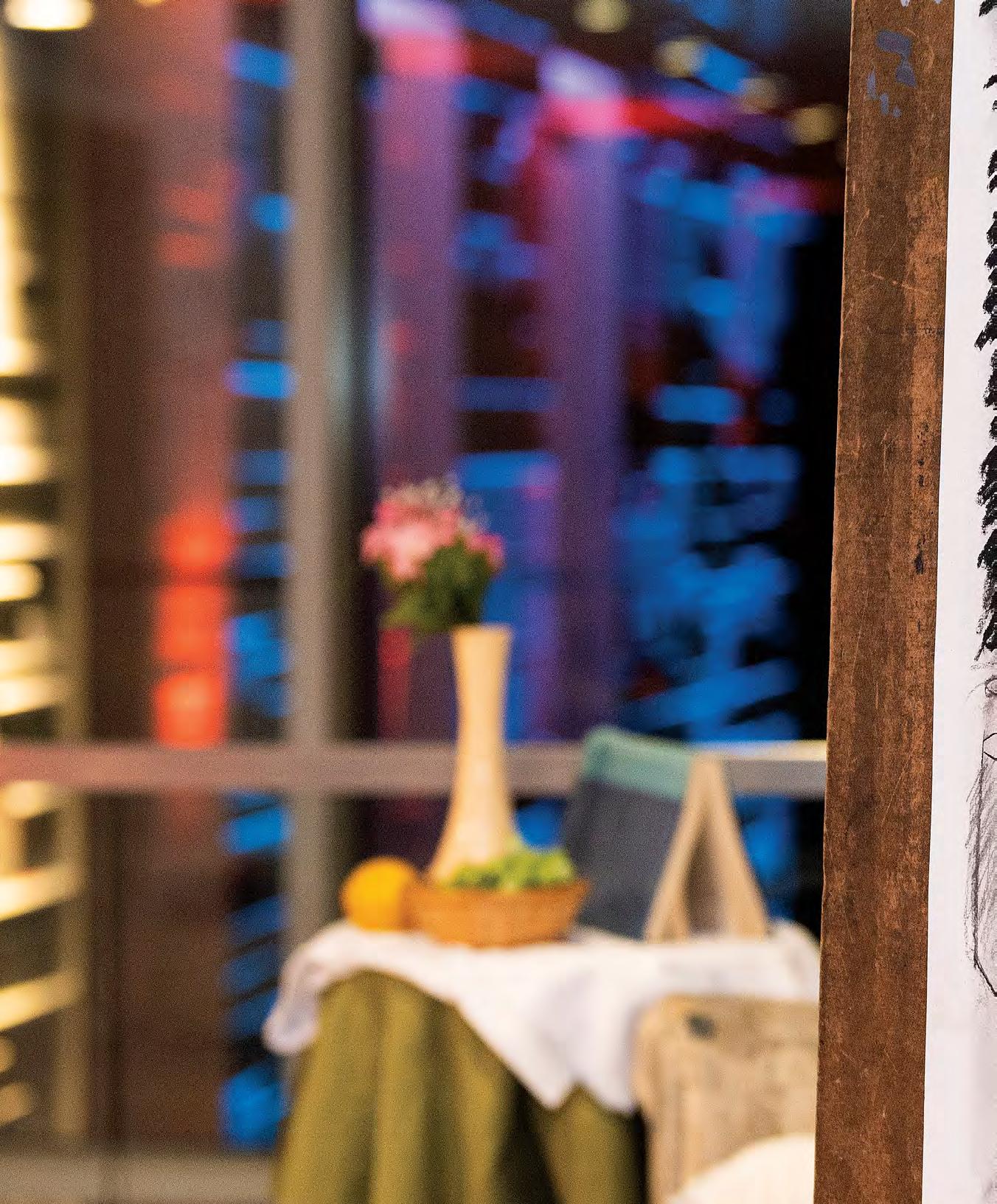

PRESIDENT
Susan Edwards, Ph.D.
PRESIDENT AND CEO, WRIGHT STATE UNIVERSITY FOUNDATION
R. Scott Rash
VICE PRESIDENT FOR ADVANCEMENT
Bill Shepard, ’91, ’15
EXECUTIVE DIRECTOR, ALUMNI RELATIONS
Greg Scharer
DIRECTOR OF MARKETING
Mark D. Anderson ’09
ASSOCIATE DIRECTOR, ALUMNI AND DONOR MARKETING AND COMMUNICATIONS
Brooke Johnson Leppla ’05, ’11
PROJECT MANAGER
Dennis Bova
DESIGN
Amanda J. Earnest-Reitmann
ASSISTANT EDITORS
Andrew Call
Chris Molnar
CONTRIBUTORS
Steven Bognar ’86
Dennis Bova
Sarah Cavender ’20
Jessica Graue ’04, ’09
Micah Karr ’19
Kara Lynch ’17
Bob Mihalek
Jen Papadakis
Kim Patton
Teresa Richter
Anthony Shoemaker ’98
Miranda Stidham
Jane Wildermuth
Chris Wydman ’94, ’97
PHOTOGRAPHY
Erin Pence
Chris Snyder
SPECIAL THANKS TO
Seth Bauguess ’13
Emily ‘Bing’ Bingham ’16
Amy Jones ’06
Kathy Kuntz
Elaine Pruner
Cristie Scharer
Dave Stuart ’04

Wright State Alumni Association Board
Wright State University Foundation Board
This is a publication of the Wright State University Foundation and the Wright State Alumni Association for the alumni, donors, and friends of Wright State University.
Submit information, comments, and letters to:
Wright State Alumni Association
3640 Colonel Glenn Highway Dayton, Ohio 45435 937-775-2620 magazine@wright.edu
Creativity takes courage
There are so many words that race through my mind when I think of describing our fine and performing arts students. Three stand out: talented, creative, hard-working.
We are lucky to witness the fruits of their tireless labor. We see their supreme talent on display when they perform. We feel their creativity when they dazzle us on the stage. Our arts students are simply amazing.
The famed French painter and sculptor Henri Matisse once said, “Creativity takes courage.” I couldn’t agree more. Being an artist takes dedication and grit. Our students master technique and engross themselves in their chosen field—one that stretches them in ways that forever change who they are. Each is a challenge that requires every ounce of their imagination, well-being, and intellect.
We at Wright State University are proud to be a part of this incredible journey. Wright State provides a dynamic training ground for career success in the arts by preparing serious, pre-professional students for careers in all facets of fine and performing arts. These highly selective programs are some of the most rigorous and exclusive academic programs we have to offer.
Wright State students studying in the visual arts, music, dance, motion pictures, and theatre learn to harness the power of their craft and its ability to express and communicate. Students participate in comprehensive conservatory training with exceptional performance opportunities from the start. Our students train to perform at the highest levels of their craft and, through that pursuit, gain a greater understanding of our world.
Alumni from our fine and performing arts programs regularly represent Wright State on the national stage. From numerous art galleries across the country, Hollywood to Broadway, and all parts in-between, their award-winning work is on display. Their roots reach back to their invaluable training and teachers on campus. At one time a local
secret, our arts programs are now wellknown locally and across the nation. The talent and hard work of our students and alumni shine a brilliant light on Wright State for all to see.
In this issue, we take you behind the scenes of our dazzling fine and performing arts annual fundraiser, ArtsGala. We’ll also share with you how arts programs are indelibly intertwined with our community. Plus, we’ll catch you up with six former arts students and find out what they’re up to today. You’ll also read about a special donor who has a passion for filmmaking and supporting motion pictures students. We’ll remember the intrepid Julia Reichert— Academy Award-winning filmmaker, feminist, and friend. And you will learn more about the many arts-related collections we have today in the Wright State University Libraries’ Special Collections and Archives. There’s so much in this edition of the Wright State Magazine. I can’t wait to talk about these stories and more the next time I see you at a performance, show, or exhibition on campus.
Sue Edwards, Ph.D. President
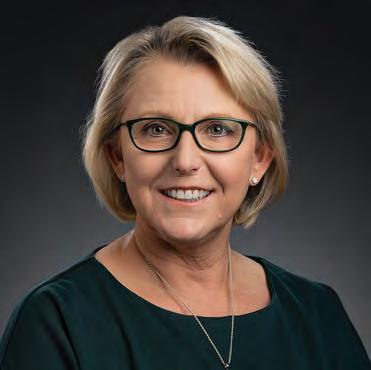
2 WRIGHT STATE MAGAZINE | FALL 2023
@WSUPrezSue FROM THE PRESIDENT
Being actively engaged with the neighboring arts groups helps students have life-changing experiences.
Updates on fine arts alumni, all outstanding in their field—including those actually living in a field in Costa Rica.

Let there be light
A


film fan
A classy and classic gala that showcases outstanding students and raises money to help those students complete their education.
ON THE COVER When given the right tools, our students can create lively and beautiful things. This cover represents the beginning of our students’ journeys and reminds us all that we start with a blank canvas, but each can choose how to use and mix the vibrant colors to create something wonderful for ourselves and our communities.
3 WRIGHT.EDU/ALUMNI 5 6 8 9 34 38 42 45 48
THE PACK CAMPUS HEADLINES LIFE AT THE LAKE THROWBACK STUDENT SPOTLIGHT ALUMNI SPOTLIGHT FAREWELLS CLASS NOTES FROM THE STACKS DEPARTMENTS CONTENTS FEATURES 34 9
FROM
22 10 Connecting arts to the community Success in the spotlight and off the grid 14 ArtsGala: A celebration of students, scholarships, and skills 26
and independent
gives back and
students achieve their dreams. 18
financial planner
helps
Take
advantage
of the benefits... Renew You r G old Card M em ber ship !
Carry your Wright State Alumni Association Gold Card with you wherever you go! Simply download your card to your digital wallet and receive your

Learn more at: wrights tate alu m ni.com/ b enefi ts
With your $50 donation you gain access to:
• Gold Member Exclusive Events
• Access to the Alumni Zone, plus other discounts
• Access to Wright State facilities
• Eligibility for Legacy Scholarships
• 15% Discount at the campus store
• And much more!
WRIGHT STATE UNIVERSITY FOUNDATION
BOARD OF TRUSTEES
Linda Black-Kurek ’78, CHAIR
Rob Weisgarber ’77, VICE CHAIR
Bill Diederich ’91, SECRETARY
Kristina Kean ’96, TREASURER
R. Scott Rash, FOUNDATION PRESIDENT & CEO (ex-officio)
BOARD MEMBERS
Martha Balyeat ’03
Anupam Bedi ’97, ’99
Dr. Samia Borchers ’81
Michael Clark ’88
Roberta Cornist-Bordeneau ( university student representative)
Michael Daniels
David Deptula ’80 (immediate past chair)
Holly Di Flora
Dr. Megan Dines ’08
David Donaldson ’88
Susan Edwards, Ph.D. (ex-officio)
Tom Gunlock
Karla Garrett Harshaw ’84, ’13
Janet Heppard ’81
Peter Julian ’71
Vercie Lark ’86
Gary McCullough ’81
Keith Meyer ’01
Hernan Olivas
Randy Phillips ’82
Marc Porter, Ph.D. ’77, ’80
Sharon Honaker Rab ’75
Bob Reynolds ’88
Dr. Michael Robertson ’11, ’14, ’16
Danielle Rolfes ’97
Natasha Sandella ‘22 (graduate student representative)
Tom Sheehan
Dr. Pamela vonMatthiessen ’98
Matthew Watson ’07
Brittany Whiteside ’06
Loghan Young ’18, ’20
Name
Member Level Gold Member
WRIGHT STATE ALUMNI ASSOCIATION
BOARD OF DIRECTORS
Dr. Michael Robertson ’11, ’14, ’16, PRESIDENT
Christopher Brookshire ’11, ’14, VICE PRESIDENT
Mary Murphy ’89, SECRETARY
Keith Meyer ’01, TREASURER
BOARD MEMBERS
Dan Baker ’12, ’12, ’15
Elizabeth Ball ’08, ’10
Sam Bernard ’11
David Bowman ’97
Amanda Burks ’05
Teresa Ebersole ’08
Christopher Hogan ’11
Karen Hunt ’86
Dr. Christen Johnson ’12, ’17, ’17
Stephanie Keinath ’06
Stacey Lawson ’94, ’96
Edwin Mayes ’89, ’96
Anna Monnett ’83, ’87
Amanda Opicka ’07, ’07
Caroline Quiett ’14
Topaz Sampson-Mills ’15
Greg Scharer (ex-officio)
Joshua Stucky ’89
Amanda Thompson ’08, ’09
Adolfo Tornichio ’94
Jerry Tritle ’81, ’83
Richard Williams (ex-officio)
Woody Willis ’83 (ex-officio)
Heather Zehringer ’11
4 WRIGHT STATE MAGAZINE | FALL 2023
FROM the PACK RAIDER

ROMANCES
Many alumni met their spouses while attending Wright State. Whether they sat next to each other in class or met through clubs and extracurriculars, hearing Raider Romance stories is always a fun reminder of the connections made possible. Here are a few of our Raider Romance stories our pack shared with us!


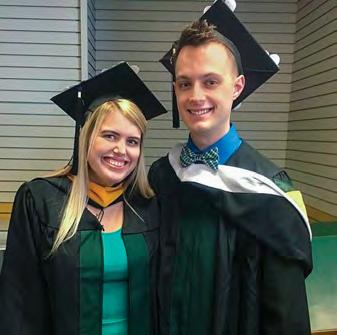


CAYLAH PHIPPS ’06 & JEFF PRESTON ’10
Caylah and Jeff became great friends in college when they both were in Greek Life and ended up working at the same college bar, Wallaby’s. Eventually, they took different paths but still remained friends. Finally, after some time, they thought, “Why not us?” They have been a happy blended family ever since.
TRISHA & MATT HIMES ’01

AUSTIN & HANNAH MILLER ’13
Austin and Hannah met in the summer of 2009 in the incoming freshman Facebook group. They lived near each other in The Woods residence halls and soon were spending many nights studying together in the library. Fast-forward to 2013 when they got engaged and took their engagement photos on campus! They now have two kids they hope will be future Raiders!


DANIEL DOUGLAS ’13, ’17 & DEVON DOUGLAS ’17
Daniel and Devon have been together since middle school starting as best friends. After getting married, they both realized they needed to continue their education and decided to tackle graduate school together as a team. Lots of long nights studying together only made it that much sweeter when they got to walk together at graduation. They even decorated their graduation caps to match.
Matt transferred from Sinclair Community College and had the luck of being seated near his now wife Trisha in class. He finally got the courage to message her on AOL Instant Messenger, and their first date was the Brooks and Dunn concert at the Nutter Center. Fast-forward to the present where they have three master’s degrees from Wright State, 22 years of marriage, and two awesome kids.
5 WRIGHT.EDU/ALUMNI
We want to see your pets with pride! Email us your address at alumni@wright.edu and we will mail you one of our Leader of the Pack bandana! Send us a photo of them with their bandana and they could be featured in our next issue and on our social media!
Alumnus Bill Shepard returns to Wright State as vice president for advancement
Bill Shepard, a two-time Wright State graduate and long-time university employee, returned to his alma mater as vice president for advancement.
T he appointment was a homecoming for Shepard, who came to Wright State as a firstgeneration college student and then spent three decades in various leadership roles at the university.
“ Wright State University is a place of opportunity and an institution that changed my life,” he said. “As a first-generation college student, I can personally attest to the impact we are having in the region.”
Shepard served as associate vice president for advancement and vice president of the Wright State University Foundation from 2011 to 2017 and assistant vice president for advancement from 2010 to 2011.

In 2017, Shepard left Wright State to become the vice president for advancement and CEO of the Eastern Michigan University Foundation, where he led that university’s successful comprehensive campaign.
He received his bachelor’s degree in geological sciences and his master’s degree in social and applied economics from Wright State.
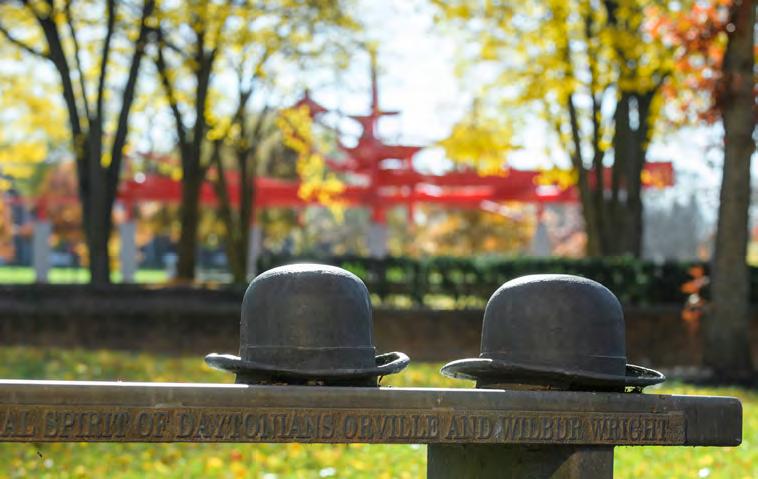
ECONOMIC VALUE OF WRIGHT STATE UNIVERSITY IN RAIDER COUNTRY
$2.3B
1.9%
27,875
out of 42
Economic impact study finds Wright State adds billions to local economy
Wright State University adds $2.3 billion annually to the region’s economy and supports nearly 28,000 jobs through its operational and research expenditures, an economic impact study found.
Wright State supplies a steady flow of qualified, trained workers to the workforce, and improves the quality of life in Ohio, with nearly 90 percent of graduates remaining in Ohio, the highest of any public institution in the state.
The report said Wright State’s total impact equals about 1.9 percent of the gross regional product of Raider Country, the 16 counties in western Ohio anchored by Wright State’s Dayton and Lake
Campuses. Wright State supports one out of every 42 jobs in Raider Country.
Wright State’s greatest economic impact on the region comes from the creativity, entrepreneurship, experience, and innovation provided by its alumni. More than 67,000 alumni, about 56 percent of Wright State graduates, make their living in Raider Country. Wright State alumni generated $2.1 billion in added income for the regional economy, which is equivalent to supporting 24,590 jobs.
The study analyzed data from fiscal year 2021–2022, or July 1, 2021, to June 30, 2022.
Sarah Hackenbracht ’03 receives honorary degree
Sarah Hackenbracht ’03 received an honorary Doctorate of Humane Letters at Wright State’s spring commencement ceremony on April 29.
“I am stunned and incredibly humbled by this honor,” she said. “It feels far too early in my career and life for such a recognition. I hope that I can use this recognition and opportunity to strengthen my support for Wright State in a meaningful way.”
Hackenbracht graduated from Wright State in 2003 with a bachelor’s degree in political science and a minor in women’s studies.
Hackenbracht was named president and CEO of the Greater Dayton Area Hospital Association in 2019. She is responsible for a team that serves the region’s 29 hospitals and health systems across 11 counties. Hackenbracht has been at the forefront of the regional response to the COVID-19 pandemic.

6 WRIGHT STATE MAGAZINE | FALL 2023 CAMPUS HEADLINES
in added income to the Raider Country economy
of Raider Country’s total Gross Regional Product
supported jobs in Raider Country
1
jobs in Raider Country is supported by activities of Wright State and its students
Raider Country is the contiguous 16-county region in Ohio anchored by Wright State’s two campuses.
Source: Lightcast, 2023 (FY 2021–22 data)
Creating a culture of well-being at Wright State
A presidential task force is working to create a culture of well-being and care on the Dayton and Lake Campuses and raise awareness of resources available to help students, faculty, and staff prioritize their mental health.
T he Mental Health Task Force is offering mental health, crisis intervention, and wellness training programs to give Wright State students and employees the resources needed to talk about mental health and refer students and coworkers who need assistance. The task force is also working to enhance counseling and support services for students, faculty, and staff and raise awareness of the importance of wellness in classrooms and around campus.
Provost Amy Thompson, Ph.D., who chairs the task force, said the group hopes to break down the stigma around mental health and foster an atmosphere of support and openness at Wright State.
Mental illness is a leading concern of college students and is the second most common reason why students leave college nationwide, making it an important retention issue for Wright State, Thompson said.
T his fall, Wright State will begin collaborating with the JED Foundation Campus Program to develop a mental health strategic plan that will include a comprehensive resource library, policy recommendations, and education campaigns and programs. JED Foundation representatives will work with the university to implement the strategic plan over four years.
Boonshoft School of Medicine receives federal grant to support mental health training for family medicine residents
Family medicine residents at the Wright State University Boonshoft School of Medicine will receive additional training to care for the mental and behavioral health needs of children, adolescents, and young adults, thanks to a nearly $2.3 million federal grant.
Family medicine residents will receive training in the prevention, identification, diagnosis, treatment, and referral of services for mental and behavioral health conditions of young people. The training will focus on mental and behavioral health problems, including substance use disorders, suicide prevention, traumainformed care, and the effects of abuse and gun violence.
Grant helps expand antiracism, social justice training in Boonshoft School of Medicine
Keith Reisinger-Kindle, D.O., assistant professor and associate program director of obstetrics and gynecology, and Erica Taylor, M.D., assistant professor of pediatrics, received a nearly $750,000 grant to expand an antiracism and social justice training program in the Wright State Boonshoft School of Medicine.
T he program uses intergroup dialogue, which has been widely used in community settings to increase trust, decrease stereotypes, establish common ground, and increase perspective-taking.
T he program is conducted by trained peer facilitators who lead participants through a series of structured activities. These activities encourage participants to investigate and explore their own personal journeys and those of fellow participants.
Air Force leader Darryl Ahner appointed dean of the College of Engineering and Computer Science
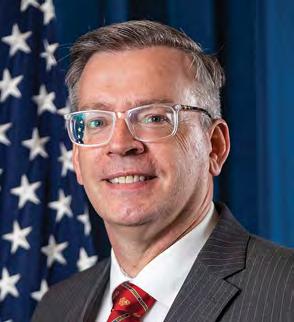
Darryl K. Ahner, Ph.D., former dean for research at the Air Force Institute of Technology at Wright-Patterson Air Force Base, has joined Wright State as the dean of the College of Engineering and Computer Science.
A s dean for research at the Air Force Institute of Technology Graduate School of Engineering and Management, Ahner led the Office of Research and Sponsored Programs and managed a $36 million research program. In addition to serving as dean, he was professor of stochastic operations research.
In 2021, he received the Medal for Exceptional Civilian Service—the secretary of defense’s highest civilian award—for workforce development and consulting activities.
A hner’s research emphasizes the optimization of test and evaluation, autonomous systems, big data analytics, reliability, stochastic models, simulation, and military operations research applications.
A hner served for 22 years in the U.S. Army in leadership and technically demanding positions, retiring in 2012.
7 WRIGHT.EDU/ALUMNI
Crossroads of Creativity
In graphics and digital, students have designs on success
BY TERESA RICHTER
designer, she launched her own wedding photography business.
Latosha Stone ’23, a recent distance learning graduate, has continued to enjoy success in the branded marketing world with her graphic design. Her notable achievements include being featured on Beyonce’s Black Parade list, and her apparel and artwork being featured in Zumiez, Hot Topic, Pop Tarts, Spencer’s, HBO’s Betty, DC Comics, and galleries across the United States.
WHY CHOOSE GRAPHIC DESIGN AT WRIGHT STATE?
THE WRIGHT STATE-LAKE CAMPUS GRAPHIC AND DIGITAL DESIGN PROGRAMS ARE LIKE THE CROSSROADS—WHERE IT ALL COMES TOGETHER—FOR SO MANY STUDENTS.
The programs strive to give students a stellar education that fosters innovative problem solving, interactive design development, and virtual solutions for comprehensive audiences.
Students pursue a rigorous curriculum of technological skill and foundational knowledge in design that enables them to be conceptual thinkers, visual communicators, and collaborative graphic and media design developers with exceptional software skills. Students outside of the graphic and digital design programs can explore two different graphic certificates that enhance the skills they have acquired in their business, fine arts, sciences, English, and marketing studies.
For a student who wishes to explore graphic design as a career, degree programs that apply to entry position production level positions include an Associate of Applied Business in Graphic Design and Multimedia, a Bachelor of Technical and Applied Studies for Graphic Design, and a bachelor’s degree

in digital design. These programs will take the student from junior level to entry management level in two to three years.
There are some fabulous alumni stories as well as some outstanding current students who are creating amazing works. A story I love to share is about Esteban Benitez ’15, ’17, ’22 who pitched a project for a local company during his senior internship.
The CEO of the company informed me that my student, this intern, had just landed the company its first million-dollar account, with BMW. Needless to say, the CEO requested that I send them four more designers immediately. Today, this company still has a large team of designers from our program.
B enitez earned a management position as a senior designer in his second year with this company. During his years there, he designed recognizable trophies for NASCAR and Fortune 500 companies that were featured on TV and red carpet events.

Several students have worked in the field as design managers, then embarked on personal startup companies that have been sustainable businesses. Sarah Puthoff Smith ’22 is just such a success story. After being in the field as a managing

The Bachelor of Technical and Applied Studies degree prepares you for employment as a graphic designer in the print, multimedia, and communication fields. You will gain valuable skills and knowledge in branding, promotional and advertising design, color theory, publication and layout, packaging design, technical illustration, design and science photography, video production, photo editing, graphic animation, motion graphics, front-end web design, HTML/ CSS, and three-dimensional printing and visualization design.
You will also strengthen your knowledge of the business environment, service marketing, and leadership strategies through applied business courses.
Students in the Wright Path program and students transferring with an associate degree from another college can complete their bachelor’s degree in as little as four semesters. Transfer scholarships are available.
8 WRIGHT STATE MAGAZINE | FALL 2023
LIFE AT THE LAKE
Teresa Richter is coordinator and lecturer of graphic design and digital design at Lake Campus, and interim director at The ONEIL Center at the Dayton Campus. You can email her at teresa.richter@wright.edu
1 2 3
AS WE CELEBRATE THE ARTS in this issue of the Wright State Magazine , we would like to recognize the fundamental role played by the Creative Arts Center in the development of the arts programs at Wright State. The Creative Arts Center will celebrate the 50th anniversary of its opening during the fall of 2024.


W hile a successful drama program had begun to take shape under the speech department during the university’s early years, the program was limited by the lack of adequate facilities on campus to stage anything other than small theater productions.

P rior to 1974, the lecture auditorium in Oelman Hall was the only space on campus that could host an audience of any size, but that auditorium was small and inadequate for a university theater program. Several productions were staged off-campus, at the old Grange Hall on National Road as well as the old New Liberty Church (also on National Road), but these were only temporary solutions as the university began making plans for a major campus expansion. This took place at a crucial period for the young university, as Wright State was trying to establish itself as a reputable, mid-sized state university while the campus was extremely small, with only the four academic buildings on the Quad, a student center consisting of two hallways, and a small dormitory.
T he first major campus expansion came to fruition in 1969 when the state legislature authorized a $14 million facilities appropriation for Wright State, providing funding for the construction of a university library, physical education building, and a performing arts center. It was the largest campus expansion appropriation for a state university to date and would double the size of the campus educational facilities.
W right State quickly went to work on an ambitious plan to develop a state-of-the-art creative arts building, which would include a grand
foyer, concert halls, theatres, an art gallery, and studio laboratories for music and fine arts. The unique architectural design would have a meandering, sculptural quality that would provide separate wings for programs in the Departments of Art, Art Education, Music, and Theater.
T he west wing housed the visual arts, including a two-level university art gallery, and craft studios for sculpture, graphic arts, ceramics, enamels, and metals. In the east wing, the music department would occupy the largest single music complex under one roof in the Dayton area, including a 400-seat concert hall and a smaller 110-seat recital hall. The new Department of Theater would occupy the center of the Creative Arts Center and have two premier performing spaces, including the Festival Playhouse, a 377-seat proscenium theatre with a balcony, and the smaller Herbst Theatre, a 110-seat “black box” customizable space.
Upon completion, Wright State had a truly innovative and distinctive facility that allowed the performing arts programs to flourish, quickly establishing the university as a leader in performing arts education and a showcase for the arts for the Dayton community. With great fanfare, a grand opening celebration for the Creative Arts Center took place on October 3, 1974, culminating with the inauguration of Wright State’s second president, Robert Kegerreis, and ushering in a new era for the young university.
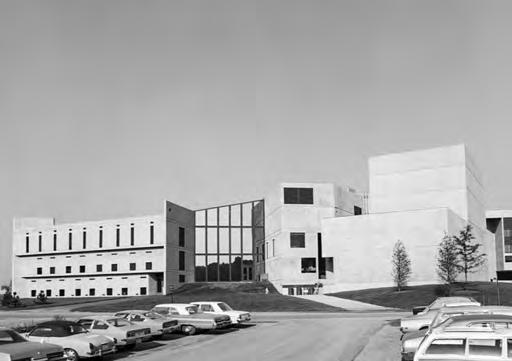
 —CHRIS WYDMAN ’94, ’97
—CHRIS WYDMAN ’94, ’97
For more information about the Wright State University Special Collections and Archives, visit libraries.wright.edu/special
9 WRIGHT.EDU/ALUMNI THROWBACK PHOTOS COURTESY OF UNIVERSITY LIBRARIES SPECIAL COLLECTIONS AND ARCHIVES
Connecting to the Community
COMMUNITY GROUPS ARE A SUPPORTING CAST FOR ARTS ON CAMPUS
BY JESSICA GRAUE ’04, ’09
The performing arts are expressed in many different ways, but there is one thing they all have in common: an audience. This means the connection the community has to the performing arts in Dayton and at Wright State University is incredibly important to maintain. Each depends on the other.
The university’s School of Fine and Performing Arts is dedicated to keeping this connection through its many programs and events. Now that all the arts are merged into one school, it allows for even further collaboration.
In 2022, the College of Liberal Arts consolidated its 10 departments into three schools: the School of Humanities and Cultural Studies, the School of Social Sciences and International Studies, and the School of Fine and Performing Arts. This school, completely based in the Creative Arts Center, includes the former School of Music and Department of Theatre, Dance, and Motion Pictures as well as the Department of Art and Art History.
“ The Creative Arts Center at Wright State is perhaps the most visible
faceplate of the university,” said Dan Zehringer, D.M.A., chair of the School of Fine and Performing Arts. “The number of patrons visiting the Creative Arts Center and using that as their orientation to Wright State, is probably the largest, single most-visited location on campus, where the greater Dayton community frequently interacts with the university.”
So what is going on in the school and how does it stay connected to the community?
THEATRE AND MUSIC
Within the Creative Arts Center, there are three venues in which to attend plays and concerts: The Festival Playhouse, The Dorothy M. & Isabel Herbst Theatre, and the Benjamin & Marian Schuster Hall. One
of the main drivers of attendance is the annual theatre subscription series. For the 2023-2024 season, tickets are $90 for adults, $88 for senior citizens, and $85 for students. Zehringer estimates that thousands of patrons annually attend these shows as well as the various concerts, recitals, and programs that are free to the public.
“Not only do they [venues] serve the campus community, but they also serve the artistic soul of the community at large. This wide variety of shows and programming generally attract more people [like] parents, grandparents, sisters, aunts, uncles, brothers, and longtime patrons, than actual Wright State students who are coming through the doors,” he said.
B eyond campus, many students get the chance to work with members of local Dayton dance, theater, and music groups. Joe Deer, distinguished professor of musical theatre and former artistic director of the School of Fine and Performing Arts, said the school has collaborated with many of these professionals, and just this past year with the Dayton Performing Arts Alliance, to perform “An Evening of Sondheim” at the Schuster Center with
10 WRIGHT STATE MAGAZINE | FALL 2023
the Dayton Philharmonic. Deer said the combined experience was incredibly beneficial to the students and created new experiences for them.
“ They were all in the room together and really singing beautifully...it was stunningly good. I could tell my students were just galvanized by it, but also [they were] in a room where they were literally double the vocal force they were used to. It was such a wonderful shared communal experience, and not something I really expected,” Deer said.
Neal Gittleman, artistic director and conductor of the Dayton Philharmonic, said the collaboration with Wright State is helpful for students because in many ways the School of Fine and Performing Arts has parallels with the Dayton Performing Arts Alliance. They both have music, theater, and dance all under one umbrella, so working together is natural.
Students get pushed out of their comfort zones when they work in a larger venue with a larger audience, Gittleman said. “It’s a different kind of exposure...it gives them a taste of what the bigger platforms that some of them hope to be in will be like,” he said. “Fundamentally, for the students, that’s the plus. And the next time they’re in
a position in a bigger theater, it won’t be a big deal.”
These connections with the community help students see their future a little more clearly, and can possibly even turn into a career. There are some Wright State graduates who are part of the Philharmonic and Dayton Ballet Company. On the flip side, there are numerous faculty members at Wright State who are also part of these local groups, including the Philharmonic and Muse Machine. These connections keep learning fresh and alive for students and the musicians.
FINE ARTS, FILM, AND FESTIVALS
When it comes to visual arts, the Creative Arts Center houses the Robert and Elaine Stein Galleries. Zehringer said there are four exhibitions per year that are a large draw. The galleries are free and open to the public five days a week and during events to provide the community with contemporary art in a variety of media.
The galleries also ask for outside artists to submit their art for some of the exhibitions. The Ebb and Flow exhibition, on display until October 2023, will feature art that evokes or inspires feelings of serenity and meditative practice as it
STAYING CONNECTED TO THE COMMUNITY
The Robert and Elaine Stein Galleries feature six gallery spaces. The Galleries host 6–10 different exhibitions per year and contain over 2,000 pieces of art.
liberal-arts.wright.edu/art-galleries
relates to nature. This is just another way the school brings in local artists from all around the community.
Another visual art popular at Wright State is the motion pictures program. This helps students meet the highest standards of the film industry, and there are several alumni who have been very successful. Hannah Beachler, a 2005 graduate, won an Oscar for production design for Black Panther in 2019.
Many people know the work of late Wright State professor emeritus Julia Reichert and former motion pictures faculty member and 1986 Wright State graduate Steven Bognar. They won an Oscar in 2020 for American Factory, a film about the Fuyao Glass America plant in Moraine. Teachers like them inspire students who often go out and do wonderful things in the community.
One of those students is Jonathan McNeal. “Julia Reichert was insistent that we utilize resources within the community to help make our films,” he said. “We got casting help from the folks at Human Race and Muse Machine. We worked with local restaurants for catering. We learned how to be better citizens while scouting locations. And we of course got to know operators of
For more information on future performances and exhibitions, visit liberal-arts.wright.edu.
Each season there are six mainstage performances in the Festival Playhouse and in the Dorothy M. & Isabel Herbst Theatre. Additionally, there is one dance event held in the Festival Playhouse and one dance concert in the Dance Studio.
wright.edu/boxoffice
The Motion Pictures Program presents the Big Lens Festival at The Neon every spring, held for two days.
Every year, the music program presents over 100 orchestra, band, choir, jazz band, and ensemble concerts recitals, and master classes in the Benjamin & Marian Schuster Hall and the Recital Hall.
12 WRIGHT STATE MAGAZINE | FALL 2023
local cinemas while looking for exhibition opportunities.”
McNeal earned his Bachelor of Fine Arts in motion picture production in 1996 and has worked as the manager of The Neon, Dayton’s arthouse cinema, for 22 years. Now he is connected to the school because The Neon is where many student and local filmmakers can showcase their work. This year and in some years past, The Neon has played host to the Big Lens Film Festival, which showcases new films by Wright State students.
There are many other festivals the school hosts on campus, including the Honor Band Festival, Fall Choral Festival, Brass Festival, Fall Strings Festival, and Winds Fest. These events bring students to Wright State from beyond just Raider Country. During the summer, Wright State normally hosts around 12 different high school marching band summer camps, professional dance camps, and choral acapella camps. This allows potential students to spend time living and working on the Wright State campus and see firsthand what the university has to offer.
“ These summer events bring in thousands of high school students from across the tristate area and from across the U.S.,” Zehringer said. “Thousands of people are on campus from June through early August when there really are not many Wright State students on campus. This facility is constantly bustling with creativity and life.”
Thanks to the subscription series to the theatre, festival, and art submissions, and the camps that are offered every year, the School of Fine and Performing Arts is doing its share of money-making and community outreach.
THE FUTURE: COLLABORATE
The school will continue to train and teach its students to hone their crafts and create works that delight people’s ears and eyes. Zehringer said part of the reason he loves his position is because the students are incredibly dedicated and have
already been honing their craft for years before they arrive at Wright State. He said many times the students are more driven because they are accepted into highly competitive programs from a national and international pool of applicants.
“A lot of our students we do consider to be from Raider Country,” he said. “Working with students, watching them learn their craft and progress as artists is really the greatest part of my job. I just absolutely love that.”
And the collaboration with the community will definitely continue. The faculty will continue to work with outside groups and help students make connections. Beyond the local groups mentioned, there are many others who are involved with the arts at Wright State, including the Dayton Contemporary Dance Company, the Dayton Opera Chorus, La Comedia, and The Human Race Theatre.
These collaborations are necessary if the arts are to continue. According to Deer, the value of higher education to a community is constantly evolving, especially since COVID-19. Being actively engaged with the neighboring arts groups helps students learn more and can help when it comes to funds. Deer said it is expensive to give students life-changing experiences, so these partnerships are perfect for the school.
“ The future has to be collaboration,” Deer said. “It has to be looking for ways that we can pool our resources because the thing no teacher wants to accept is a reduced experience for their students...it’s easy to become disconnected in certain ways.
“I think the future for the School of Fine and Performing Arts and for Wright State is finding its way to connect with our community, and to see and hear our community and for them to see and hear us in ways that feel relevant and urgent.”
Save the Date
EBB AND FLOW ART EXHIBITION
August 29–October 28, 2023
DAYTON ARTSLIVE
Levitt Pavilion
September 21, 2023 | 7 p.m. community.wrightstatealumni.com/ ARTSLIVE2023
THE LIAR
Festival Playhouse
September 29–October 8, 2023
FALL STRINGS FESTIVAL
Creative Arts Center
October 5–7, 2023
KELLY THE DESTROYER VS. THE SPRINGFIELD COBRAS
Herbst Theatre
October 20–29, 2023
CABARET
Festival Playhouse
November 3–19, 2023
BY THE BOG OF CATS
Festival Playhouse
February 1–11, 2024
A DOLL’S HOUSE
Herbst Theatre
February 15–18, 2024
A DOLL’S HOUSE PART 2
Herbst Theatre
February 22–25, 2024
THE 25th ANNUAL PUTNAM COUNTY
SPELLING BEE
Festival Playhouse
March 15–31, 2024
ARTSGALA
Creative Arts Center
April 6, 2024
DANCE ENSEMBLE SPRING CONCERT
Festival Playhouse
April 18–21, 2024
For more information on future performances and exhibitions, visit liberal-arts.wright.edu.
13 WRIGHT.EDU/ALUMNI

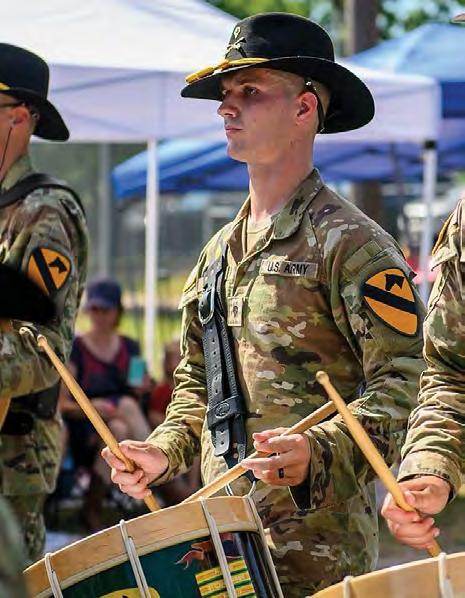
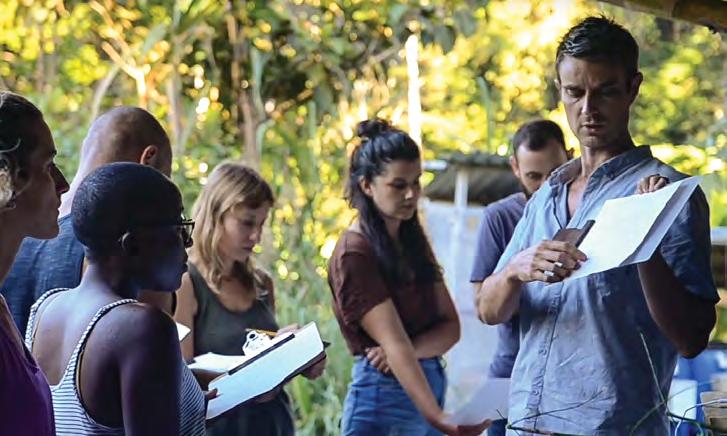
PHOTO CREDIT: JENNIFER ZMUDA
SUCCESS in the spotlight & off the grid

A look at where fine arts students are now
BY MICAH KARR ’19
The innovative, entrepreneurial Wright brothers —those bike shop owners from Dayton—became the fathers of modern aviation through an incredible amount of hard work and dedication. They traveled the United States to ensure the safety of the aviation breakthroughs they pioneered.
Wright State alumni walk in the footsteps of Wilbur and Orville, together the university’s namesake. Many travel the country, or even the world, during their time at the university and after their graduation. Raiders from every college have continued to explore new horizons.
Many of Wright State’s creative arts graduates have gone on to achieve multiple awards and commendations. Alumni have worked on television shows like Only Murders in the Building, movies like Wakanda Forever, and musicals like Hadestown. Some work in their field; others branch out to new horizons.

Wright State dance graduates are performing in companies and venues locally and around the world, including the Luna Negra Dance Theatre, Dayton Contemporary Dance Company, Rockettes at Radio City Music Hall, Battleworks, Forces of Nature, Wylliams/Henry Contemporary Dance Company, BalletMet, Ballet Noir, Hirabayashi Dance Theatre, and Disney World, as well as on cruise ships, national tours, and Broadway.
Music performance and music education majors often go on to teach music to others at schools or serve as worship leaders
15 WRIGHT.EDU/ALUMNI
PHOTO CREDIT: AB SESAY
in religious settings or as private music instructors. Graduates have also gone on to become college professors in several states.
One of these accomplished alumni is William Kan. Kan graduated from Wright State in 2017 with a bachelor’s degree in music performance with a focus in percussion. His achievements began before he graduated. He received multiple scholarships and the Robert Stofer Award, the most prestigious award offered by the former School of Music. The award, voted on by faculty, is given to a junior or senior student displaying excellence in performance abilities, service to the department and the university, and excellence in studies.
Since graduating, Kan has performed with several orchestras around the country, including the Buffalo Philharmonic, Erie Philharmonic, Lansing Symphony, Indianapolis Chamber Orchestra, Terre Haute Symphony, Caramel Symphony, BaldwinWallace Conservatory Musicals, Canton Symphony, Cleveland Philharmonic, and Springfield Summer Musicals.
While Kan was a student at Wright State, he performed over 80 times for the Wright State Concerto, Wright State Foundation, school deans, and the university president. Kan also met his wife, Elizabeth, while he was a student.
After graduation, Kan received a graduate teaching assistantship position with the University of Georgia. Midway through his master’s degree program, a friend of Kan’s encouraged him to audition for the Army band.

After auditioning, Kan was accepted into the Army band and quickly won a position with Pershing’s Own, considered
the Army’s premier musical organization.
Kan is now considered a special band musician. These musicians are stationed in Washington, D.C., or West Point and often support high-profile events such as presidential inaugurations, burials at Arlington Cemetery, and arrivals of foreign and domestic dignitaries.
Kan is not the only Wright State fine arts alumnus to travel the country. Fran Kick graduated from Wright State in 1987 with a Bachelor of Arts in music education. Kick taught band at Centerville High School before taking a leave of absence to develop a speaking career.
Since 1998, Kick has served as the leadership coordinator for the Music for All Summer Symposium. He also serves as a strategic educational advisor for Music for All throughout the year.
Today, Kick speaks at conventions, colleges, nonprofit organizations, and other groups. He has worked with over 1,000 domestic and international organizations, schools, summer camps, and companies—including Procter & Gamble, the U.S. Army, and the Ohio Department of Education.

Many Wright State alumni have gone on to Broadway—some as dancers, others as directors. Dionysia Williams has run in multiple Broadway circles. She is a director, choreographer, actor, and dance instructor.

After graduating from Wright State in 2006 with a Bachelor of Fine Arts in musical theatre, Williams traveled across the United States and internationally in Broadway musicals like Grease, Fame, Cats, West Side Story, Anything Goes, and The Pajama Game. She also has performed regionally in Saturday Night Fever, Pippin, The Performers, Spamalot, A Chorus Line, Fugitive Songs, Marvelous Wonderettes, and Forbidden Broadway, Vol. 1.
Williams, like many of her compatriots in the fine arts, strives to teach others her craft. She teaches jazz, tap, and musical theater styles of dancing. Currently, she
16 WRIGHT STATE MAGAZINE | FALL 2023
FRAN KICK ’87
WILLIAM KAN ’17
DIONYSIA WILLIAMS ’06
PHOTO CREDIT: JENNIFER ZMUDA
teaches at the BalletMet Dance Academy in Columbus, Ohio. She has also served as a director and choreographer at Wright State, the Human Race Theater Company, the Short North Stage, the Shenandoah Summer Music Theatre, the Contemporary Theatre of Ohio, and the Columbus Children’s Theatre.
Tilly Evans-Kruger, originally from Wisconsin, graduated magna cum laude with a Bachelor of Fine Arts in dance in 2014. After her graduation, EvansKruger went on to continue her dance education at the Neighborhood Playhouse in Manhattan, a highly respected acting school. The school was described as the most respected acting school in the country by the Cambridge University Press. Evans-Kruger has been trained for performance on camera at the Kimball studio, also in Manhattan.
Throughout her career, EvansKruger has performed with the Dayton Contemporary Dance Company, the Spectrum Dance Theater in Seattle, and BODYTRAFFIC Contemporary Dance Company in Los Angeles. She has worked with Texas-based choreographer, director, and educator Peter Chu, New York City-based Tony Award-winning choreographer and director Sonya Tayeh, and Camille A. Brown, a choreographer and dancer who encourages her company to focus on an introspective approach to cultural themes of race.

While many alumni thrive in the spotlight, at least one other avoids it and shows others how to do the same. Ian Macaulay, a 2006 Wright State fine arts graduate, and his wife, Ana Gaspar, teach people to live off the grid from their home in Costa Rica.

Featured in publications like the New York Times, Vice, Whetstone, and Heraldo De Aragon, Macaulay and his wife teach others to live sustainably. They educate the public on how to begin growing their own food in a sustainable, eco-friendly fashion.
Two years after he graduated, Macaulay
and Gaspar bought an abandoned cattle farm. They began their work to rejuvenate the area for growing food and living sustainably.
Macaulay and Gaspar have been teaching courses from their home for over 10 years. These courses encourage participants from around the world to homestead. Mornings are dedicated to how-to lessons like preparing vegetable beds and compost, managing soil pH and fertility, and planting sustainable staple crops. They also educate their students on waste management, home design, and maintaining their growing crops in a cost-efficient, off-grid lifestyle.
In the afternoons, Macaulay and Gaspar offer lectures on a variety of topics, such as applying permanent changes to culture on a world scale, how to make a profit on living off the land, and comparing and contrasting the best practices for living off the land in various climates. Living off the grid in Costa Rica and living off the land in Dayton are very different.
Wright State graduates have gone on to thrive and create a better world in so many ways. Fine and performing arts graduates have taken to the stage, gone behind the scenes, and gone to new horizons to create incredible art on the stage, on our walls, and in our ears.
Every one of the university’s colleges has its success stories, but Wright State’s fine and performing arts students bring success to the spotlight—or off the grid.
17 WRIGHT.EDU/ALUMNI
your success! Submit your class notes and updates at wrightstatealumni.com/classnotes
Share
IAN MACAULAY ’06
TILLY EVANS-KRUGER ’14
PHOTO CREDIT: AB SESAY
Let there be LIGHT
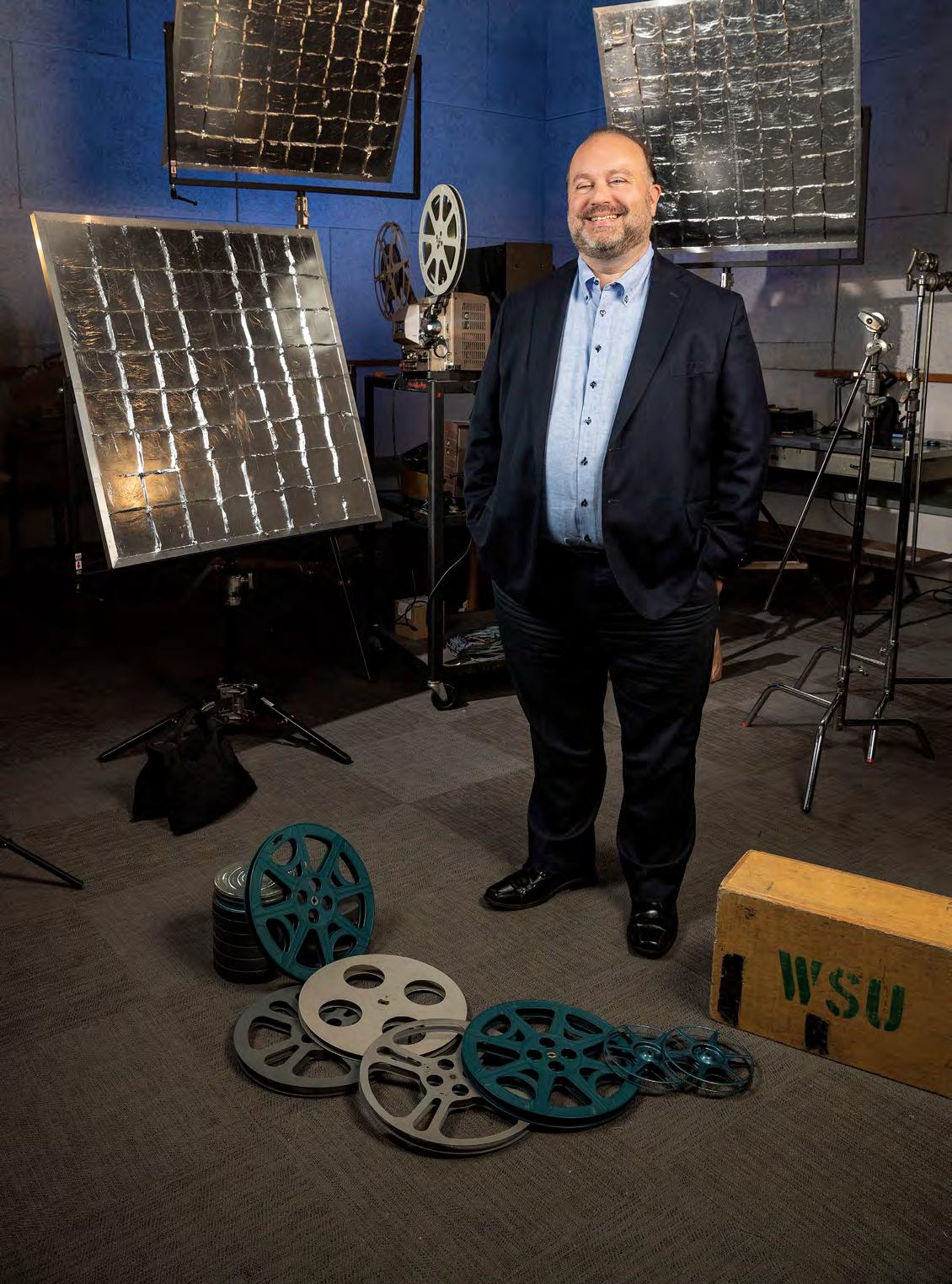
FINANCE EXPERT WITH LONGTIME LOVE FOR FILMMAKING HELPS MOTION PICTURES STUDENTS
BY ANTHONY SHOEMAKER ’98
An independent film fan who likes “quirky dramas,” Black admires the work of independent filmmakers such as Blue Velvet’s David Lynch and Out of Sight and Traffic director Steven Soderbergh.
“I was interested in editing, directing, and writing,” Black said. “As the time came for me to go the college path I talked about wanting to go to film school to continue my interest in entertainment. I originally was wanting to go into the motion pictures department.”
Black’s parents were not sure a bachelor’s degree in motion pictures was the best choice for a stable career. His parents said they would help him pay for college, but he would need to pursue his film interest as a hobby and maybe get back into it after graduation.
Instead, Black’s parents wanted him to focus on his business and investment interests. His father Merlin, who worked at Dayton Power & Light (now AES Ohio), introduced him to investments and financial markets as a teenager and helped him chart his career path in business.
Black graduated summa cum laude from the Raj Soin College of Business
in 1994 with a B.S. in financial services. A successful local financial planner, he never stopped loving film or Wright State and has made several donations to the university over the years. His most recent donation in December was to the motion pictures program to provide much-needed equipment for new filmmakers.
“I’ve been a supporter of the university since I graduated. I’ve donated my time and money. Things have just come to a point where I wanted to do something specific for the film department as a continuance of my interest in arts and film and entertainment,” said Black, who lives in Beavercreek and grew up in Bellbrook.
After shutdowns from the COVID-19 pandemic and with continuing supply chain issues across the country, Black knew the motion pictures program could likely use some new equipment. “What’s the film school shopping list for equipment that they need?” Black said he asked when considering his donation to the program. “Give me the top five things the film school is seeking and I’ll start there.”
Lighting boards were at the top of the wish list, said Parker Bowling, equipment
and facilities manager in the motion pictures program. The school bought four Matthews Studio standard 42x42-inch reflector boards with Black’s donation.
“We didn’t have any of these, it’s a great development in our gear wheelhouse,” Bowling said. “The donations are a wonderful addition to our budget.”
The lighting boards have many uses but are mainly used for filming outside. When there are no outlets for lights or electric generators available, the boards provide a quiet way to make use of sunlight.
“ They have a really reflective side on both with a special kind of foil that really does a good job of pushing light back on what you’re aiming it at,” Bowling said. The boards are manufactured with tempered glass mirrors. They are made of honeycomb material placed between two sheets of aircraft aluminum.
B owling said the classic 1950 Japanese film Rashomon by Akira Kurosawa was one of first movies to use a similar lighting technique with a large mirror to get sunlight on actors’ faces when they were under trees. Cinematographer Kazuo Miyagawa used a mirror to reflect the sun’s natural light on actors hidden in the shadows. Bowling said the new lighting boards are a modern development of that classic technique.
The Matthews brand lighting boards are available for students to check out and use in their film productions. Bowling says a
19 WRIGHT.EDU/ALUMNI
Mark Black wanted to make movies before he attended Wright State University in the early 1990s.
lot of students will take advantage of the new equipment because, prior to having the new lighting boards, the program had little to no exterior lighting capabilities. The closest thing the program had for students to use were bounce boards, which were recycled posters from Wright State’s theatre program.
“We have started using the new ones. They are many times more powerful than anything else comparable we have had,” Bowling said. “It’s a very versatile piece of equipment.”
The motion picture programs that will benefit most from the new lighting boards include junior documentary, narrative, and senior thesis works. Black wanted his donation to be for something to “satisfy a gap with something that they could use right off the bat,” he said.
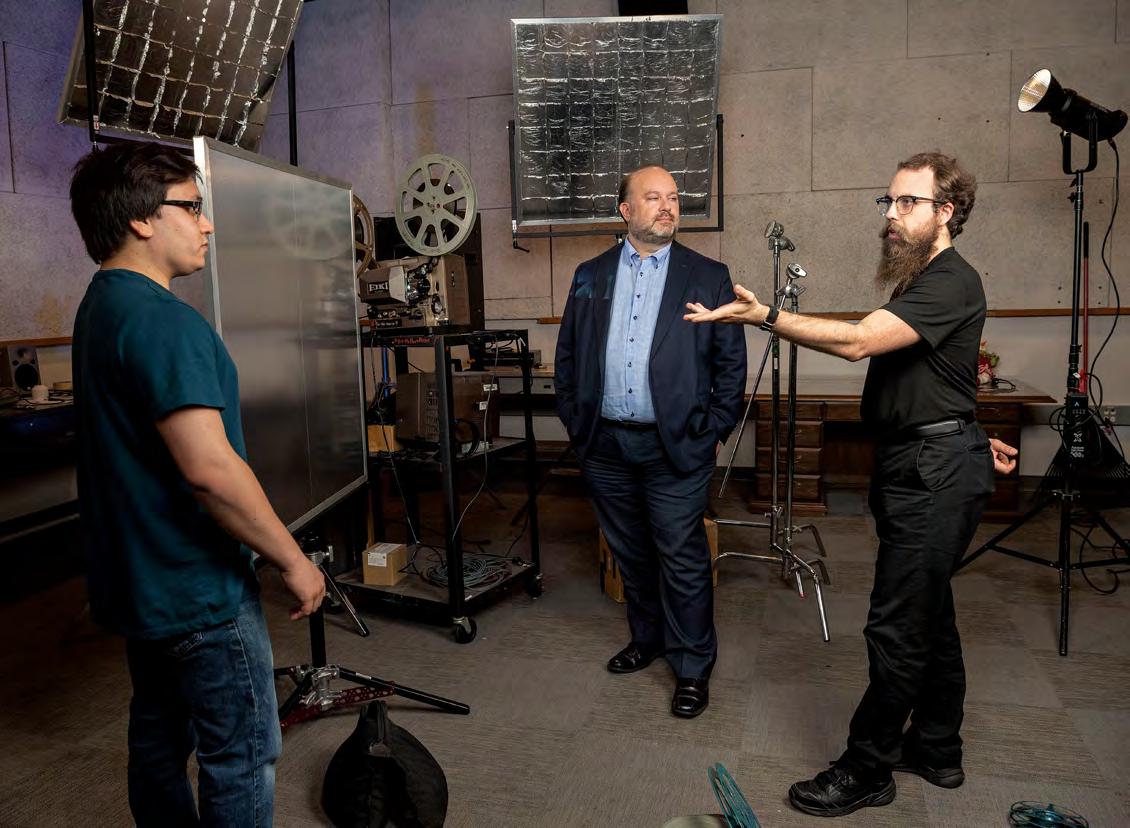
20 WRIGHT STATE MAGAZINE | FALL 2023
“I’ve been a supporter of the university since I graduated. I’ve donated my time and money. Things have just come to a point where I wanted to do something specific for the film department as a continuance of my interest in arts and film and entertainment.”
MARK BLACK ’94
BLACK RECENTLY VISITED WRIGHT STATE’S TOM HANKS CENTER FOR MOTION PICTURES TO DISCUSS THE NEW LIGHTING BOARDS PURCHASED WITH HIS DONATION.
Motion pictures student Mason Perry, who plans to graduate next year, used the new lighting boards last semester during a film shoot in Dayton.
“ The reflectors have really been helpful on sets. While you are dependent on the sun showing itself, they let you harness the power of it,” Perry said. “They provide light quality equivalent to a bigger light but with no electric. This also allows us to get light without using generators, which provide noise. So, all in all, it makes for a quieter and more efficient exterior shoot that’s quicker and easier to set up.”
The boards can also work in conjunction with high-powered lights and an overhead frame to give film students more control over their image.
Black recently visited the film school to see the new lighting boards purchased with his donation. His last visit to the school was when it was rebranded the Tom Hanks Center for Motion Pictures in 2016.
Since graduating from Wright State, Black has worked as a certified financial planner and, in 2009, started his own financial planning firm, Vantage Point Financial Services, based in Centerville.
Wright State “set the stage for personal and professional successes,” Black said. In addition to his degree, Black also met his wife, Lori, through the university.
“It’s a double benefit to Wright State. Successful career, successful marriage,” Black said.
They have two children: Caitlin is a nurse in Lexington, Ky., and Adam works with his dad at Vantage Point.
Black credits his love for Wright State to his mother, Judith. She graduated from the university with an education degree in 1970 and was Wright State’s first basketball cheerleading adviser. “She was always at dinner talking about Wright State. Wright State this, Wright State that. It just kind of fit in since I was planning to stay in the community to go to college,” Black said.

In addition to his financial support of the university, Black previously served on the Wright State Alumni Association Board of Directors.
Wright State, Black said, “is a gem to have in the community. It’s a great resource to have.”
To support our students in motion pictures, please visit wright.edu/give/mopixfund
21 WRIGHT.EDU/ALUMNI
BLACK, PICTURED WITH HIS MOTHER, JUDITH, WHO GRADUATED FROM WRIGHT STATE WITH AN EDUCATION DEGREE IN 1970. SHE WAS WRIGHT STATE’S FIRST BASKETBALL CHEERLEADING ADVISER.
REMEMBERING Julia Reichert
Filmmaker, pioneering feminist, friend
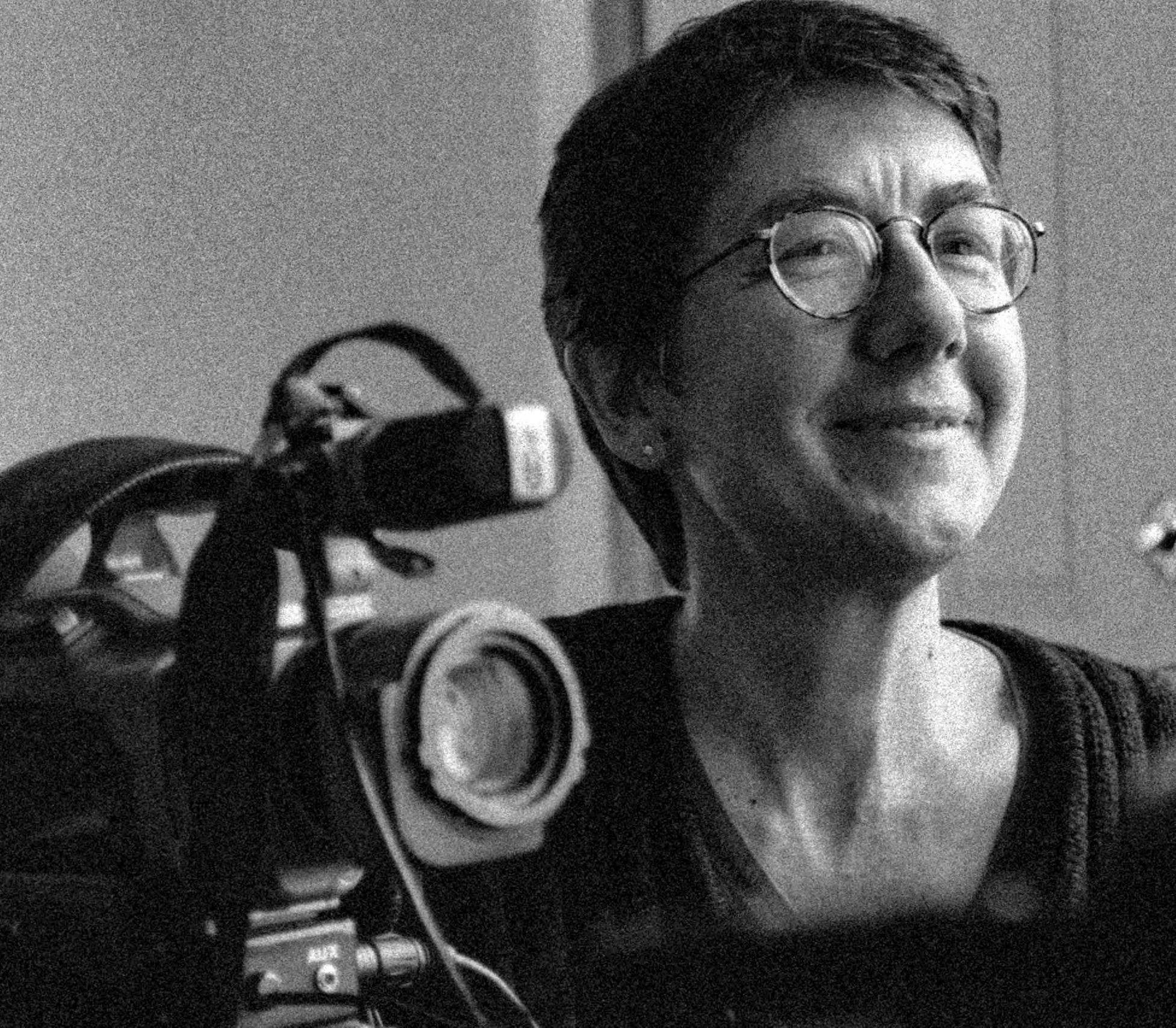 BY JEN PAPADAKIS
BY JEN PAPADAKIS
Where are all the women?
Julia Reichert asked this as she scanned the audience of mostly male film students gathered to hear her speak at the Tom Hanks Center for Motion Pictures. It was only three days after her Oscar win for American Factory in 2020, and she was in active treatment for terminal urothelial cancer, a disease she had been battling since 2018.
Her head was bald from chemotherapy treatment and, if she was exhausted from
22 WRIGHT STATE MAGAZINE | FALL 2023
whirlwind travel, she is remembered for not showing it.
She passed the Oscar trophy around the room, encouraging students to hold it and feel its weight. “We did this to make them understand this is attainable,” Reichert said.
It was not the first time Reichert had asked “Where are all the women?” of a room, an industry, or the world. From the start of her career, she pioneered coverage
of working women and women’s struggle for equality.
Several of her films reflect her desire to center the stories and experiences of women. In 1969 she hosted The Single Girl on WYSO. This program is considered by some to be the first openly feminist radio program in the United States.

In 1970, Reichert and Jim Klein created the documentary Growing Up Female, which chronicled the way women
are socialized. The film was the first documentary of the modern women’s liberation movement. In 2011, it was added to the Library of Congress National Film Registry.
In 1976, she and Klein made Union Maids, about three women who were key to the early organization of the labor movement, a film also added to the National Film Registry in 2022. In 2020, she and Steven Bognar released 9 to 5: The Story of a Movement, which gave the history of the real-life women’s labor movement.
These are not Reichert’s only films. Her subject matter ranged from feminist stories to stories of substance use, from the history of the American Communist Party to the heartbreak of childhood cancer, from the changing realities of American labor and manufacturing and its effect on a small town to filming behind the scenes with world-famous comedians.
Reichert is remembered for a tenacious commitment to her work, community, and family as well as for her unrelenting belief that collective action and solidarity can inspire social change.
Reichert was a four-time Academy Award nominee, two-time winner of the Prime Time Emmy, and recipient of a national touring retrospective, “Julia Reichert: 50 Years in Film”, which debuted at the Museum of Modern Art in New York.
She was heralded as “the godmother of documentary filmmaking” at her death on Dec. 1, 2022. She was 76.
Hundreds of former students, colleagues, clients, and friends traveled from across the country for a memorial service in Reichert’s beloved village of Yellow Springs on May 6. There, The World House Choir sang “Union Maid” in homage to her 1976 film. It was also a tribute to her role at the “forefront of a new generation of social documentarians...with a belief in film as an organizing tool with a social mission,” as J. Hoberman wrote in her New York Times obituary.
From the outside, it was difficult to see what the diverse group of memorial attendees had in common—a tribute
23 WRIGHT.EDU/ALUMNI
REICHERT FILMING THE 2006 DOCUMENTARY A LION IN THE HOUSE , WHICH FOLLOWS FIVE FAMILIES ACROSS SIX YEARS AS THEY FACE AND FIGHT CHILDHOOD CANCER. SHE CO-DIRECTED THE FILM WITH STEVEN BOGNAR ’86.
PHOTO CREDIT: STEVEN BOGNAR ’86
CLOCKWISE FROM TOP LEFT: JULIA REICHERT INSPECTING FILM IN 1973; REICHERT WITH CO-DIRECTORS MILES MOGULESCU (LEFT), JIM KLEIN (RIGHT), AND CAST MEMBER VICKY STARR (FAR RIGHT) AT THE 1977 ACADEMY AWARDS, WHEN UNION MAIDS WAS NOMINATED FOR BEST DOCUMENTARY FEATURE; WRIGHT STATE MOTION PICTURES PROGRAM STUDENTS’ FIELD TRIP TO CITIZEN JANE FILM FESTIVAL IN 2013; REICHERT, ALICIA WEBER, AND CODIRECTOR JIM KLEIN ON A SHOOT FOR THEIR 1974 DOCUMENTARY METHADONE: AN AMERICAN WAY OF DEALING ; REICHERT AND STEVEN BOGNAR ’86 VISITED CAMPUS TO CELEBRATE THEIR 2020 OSCAR WIN WITH WRIGHT STATE STUDENTS AND FACULTY MEMBERS; BOGNAR AND REICHERT AT THE 2020 ACADEMY AWARDS, AT WHICH THEY WON AN OSCAR FOR AMERICAN FACTORY IN THE BEST DOCUMENTARY FEATURE CATEGORY.

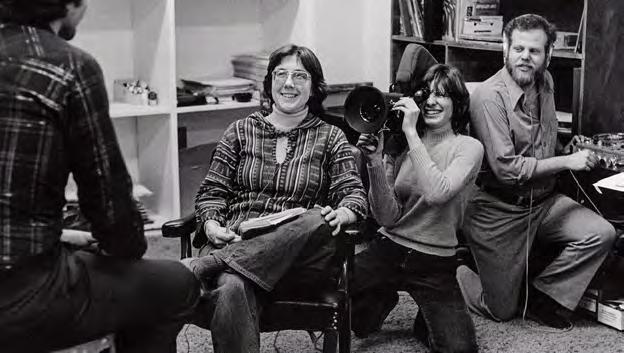
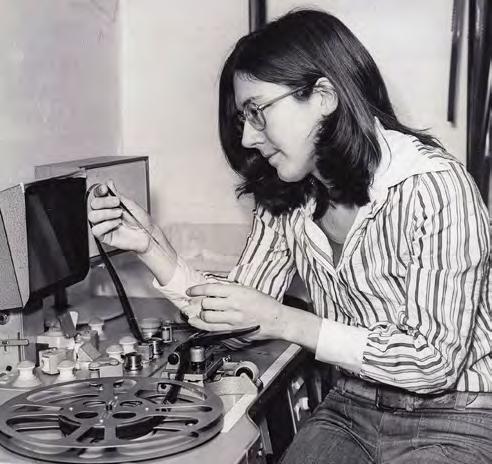
PHOTO CREDIT: STEVEN BOGNAR ’86 & UNIVERSITY LIBRARIES SPECIAL COLLECTIONS AND ARCHIVES

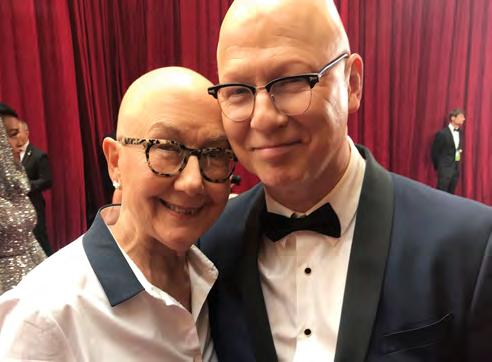
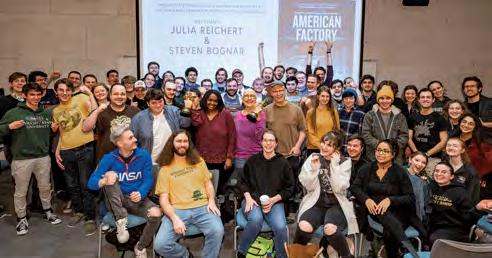
24 WRIGHT STATE MAGAZINE | FALL 2023
to Reichert’s ability to listen to and value people from all backgrounds and experiences and keep them in her life. Filmmakers from Los Angeles stood next to factory workers from Fuyao Glass America. A woman in a vintage protest T-shirt kindly shared her rumpled tissues with the family next to her.
When asked how they knew Reichert, all of them used the word “friend.”
Selena Burks Rentschler ’03 paid tribute to Reichert’s role in her life, remembering Reichert’s steady devotion to her students in each chapter of her own life, even in the face of her own losses or struggle.
Shortly after the death of her mother, Reichert surprised her students by attending the screening of their films at the Little Art Theatre. “We had flowers just in case she was still able to show up,” Rentschler said. They had a hunch she would.
“Julia was always saying, ‘As filmmakers we have to think about what kind of world we want to live in,’” Neenah Ellis, former executive director of The Eichelberger Center for Community Voices at WYSO, shared with the crowd. “Julia made a life for herself that balanced her career, her family, and her community. She [was] committed—in her photographs, her radio programs, her classroom, her films, and the work-of-art that was her life in Yellow Springs.”
Reichert grew up in Bordentown, N.J., and was one of only a handful of her high school graduating class to attend college. She made her first film as an undergraduate student at Antioch College and from that point on devoted her life to filmmaking, storytelling, and educating future generations of filmmakers.
Reichert perfected the art of storytelling and listening, with an expert eye for stories that captured the social issues plaguing the Midwest region she devotedly called home. “We had a special ear to the heart of America,” she said of her spouse and filmmaking partner, Steve Bognar. “You don’t just dive in and out. You sit with people, at the bar, at their kitchen table, at their bedside. You have to commit.”
Reichert helped lay the foundation for Wright State’s motion pictures program near its inception, joining the faculty ranks with her then-husband and longtime filmmaking partner, Jim Klein. Her focused commitment to her students’ careers paved uncharted paths to national and international success for Wright State graduates over her 28-year tenure.
She is heralded for her intentional pedagogy cemented in apprenticeship and enlisted many of her former students to work with her on her films, an opportunity that would arguably have been a further reach for Midwestern students had she not been so devoted to the Miami Valley and the talent she saw and nourished around her.
Her equal devotion to the growth of her students, commitment to evolving her best-in-class practice, and quest for excellence drove decades of success and helped the motion picture program receive national recognition. Many of Reichert’s former students are prestigious, award-winning names in film and committed artisans of their craft, carrying on the example of their mentor.
Reichert’s students included Academy Award winner Hannah Beachler ’05, Karri O’Reilly ’98, Nicole Riegel ’09, Sherman Payne ’04, and Erik Bork ’89. In addition to her tenure at Wright State, Reichert taught courses at Antioch College and American University and was a guest lecturer at Harvard and Yale.
Reichert was buried in Woodland Cemetery in Dayton. In addition to Antioch, a memorial ceremony took place in New York City.
To support Julia Reichert’s passion for independent filmmaking at Wright State, please visit wright.edu/give/mopixfund
“She was a champion of women and loved film. She took us rag-tag kids and helped shape us all into filmmakers and storytellers.”
Hannah Beachler ‘05
Academy Award-winning production designer, Black Panther, Creed, and Beyoncé’s visual album Lemonade
“Julia Reichert was such a rare talent, a rare colleague and friend. Julia lives on in her films, and each one stands as a testament to the human spirit, with profound insight into the human condition. She was one of those rare people—and I hear this from all of those who knew her—who, when you were with her, was totally in your presence, as you were in hers. She, as much or more than anyone I’ve ever known, was an authentic people person; always in the moment, listening, learning, and loving.”
W. Stuart McDowell
Former Chair, Department of Theatre, Dance, and Motion Pictures
“Julia was the first person who really believed in and supported me as a potential storyteller, pushing me to stretch beyond my self-imposed limits to rise up to higher levels. Having her as a teacher meant having a lifelong advocate and friend who helped you however she could and cared deeply about what you were doing while inspiring you with what she was creating in the world. Her natural curiosity, engagement, intelligence, and goodwill made her the ideal conversation partner, and over the 38 years since I met her, she’s played an outsized role as one of a handful of the most positively impactful people in my life.”
Erik Bork ’89
Two-time Emmy- and Golden Globewinning writer/producer
“The enormity of Julia’s contribution to film history and the Ohio film community is matched only by how deeply everyone she impacted is grieving her loss. Julia was my teacher, mentor, and friend for over 30 years. She laid a strong foundation for our closeknit MoPix alum community, and we will forever be grateful.”
Nichol Simmons
Sundance Film Festival winner and former motion pictures program adjunct faculty member
25 WRIGHT.EDU/ALUMNI
A celebration of students, scholarships, and skills
BY DENNIS BOVA
FOR ONE NIGHT A YEAR, the Creative Arts Center, with all its classrooms, performance spaces, and nooks and crannies, becomes a giant stage. The night’s impressive cast of entertainers—no mere players—are students who sing, dance, act, paint, perform, and enlighten the throng who have come to see what Wright State has wrought in its wide-ranging arts programs.
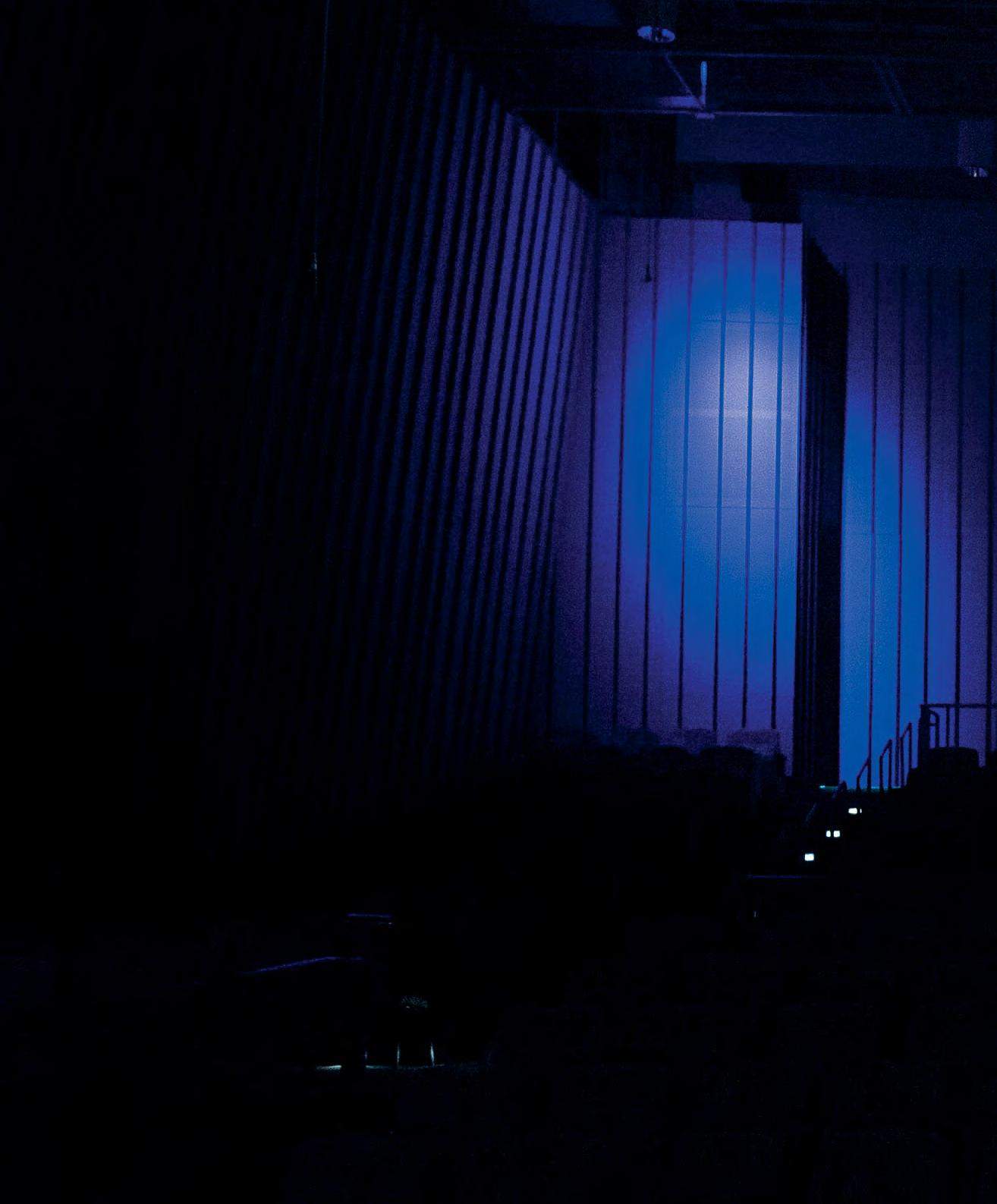
Such is ArtsGala, a classy and classic gala for the arts that raises funds to benefit these students and others who will follow.
“ArtsGala has a trifold effect,” said Dan Zehringer, D.M.A., chair of the School of Fine and Performing Arts. “Most important, it raises money for us to give to students in the form of scholarships every year. The second aspect is that it benefits the university. It allows us to really shine and provide an opportunity for the Wright State community to see all the different things we do. Third, it raises the level of awareness in the region of what we offer here.”
April 1, 2023, was the 24th ArtsGala, making a triumphant return to its roots following pandemic restrictions.
What went into producing it might come as a surprise.
“What people might not necessarily know,” said Marya Spring Cordes, associate chair of the School of Fine and Performing Arts, professor in acting/ musical theatre, and artistic director of the theatre program, “is that we spend a whole year organizing it the minute after ArtsGala is over.” Much of that planning goes toward marketing, securing sponsorships, and assembling gift packages for the silent auction.
That’s where Rebecca Foley stepped up. New to Wright State in January as coordinator of the Robert and Elaine Stein Art Galleries, she quickly came up to speed on all things ArtsGala, where she became coordinator. “When I was interviewing for the position,” she said, “I heard from students how the scholarships from this event impacted them. The stories were phenomenal. That to me is the heart of the event and made me be interested in being here.”
 ALEXIS ARIANA ’23 (MUSICAL THEATRE) REHEARSES FOR THE ARTSGALA OPENING CEREMONY.
ALEXIS ARIANA ’23 (MUSICAL THEATRE) REHEARSES FOR THE ARTSGALA OPENING CEREMONY.
Helping Foley was Becca Webb, director of enrollment management and community engagement for the College of Liberal Arts, who organizes the silent auction and oversees ticket sales, one of the primary revenue streams financing the scholarships. ArtsGala generates $150,000 annually for scholarships.
“ That money goes directly to the students,” Webb said. “It goes toward their tuition, books, music books—whatever they need to spend their money on to realize their dreams.”
Webb has an interest in those students and enjoys seeing them succeed.
“One of the best parts of ArtsGala is you get to see where the money is going. You see them performing their art. You don’t get to see that in a lot of other cases.”
“I have my dream job in enrollment management. I bring these students to Wright State, and I get to see them perform and do what they love. There’s an energy that I see.”
She tells of fine arts students whose parents tell them that this isn’t a career. Yet those students at ArtsGala have the opportunity to interact with attendees
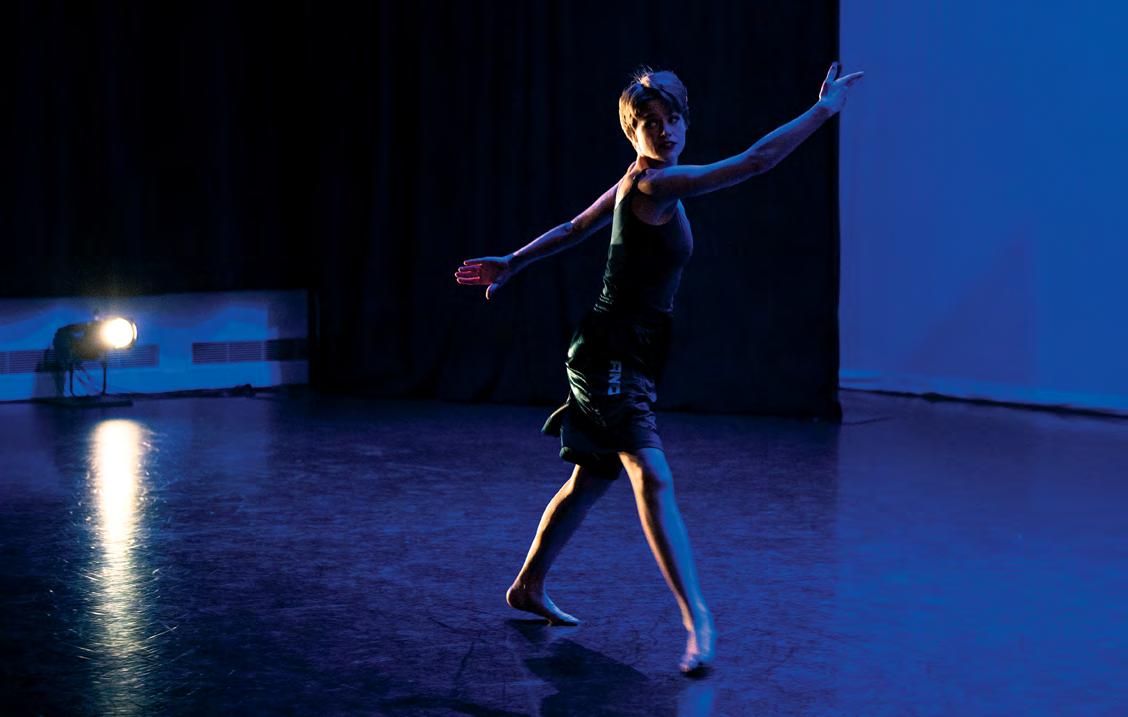
who, by buying a ticket or having a winning bid on an auction item, finance their scholarships. “This pairs them with the people who can get them to their dream. Those students say that the money is making a difference, and their art is making people happy. I’m getting emotional just thinking about it. It’s so rewarding.”
After the sponsorships are lined up and all the other logistical details come into focus, there is the beehive of activity in the week leading up to ArtsGala. “The entire building is consumed with transforming what is an education facility into an entertainment facility,” said Joe Deer, distinguished professor of musical theatre and former artistic director of the School of Fine and Performing Arts. Classrooms become stages with lighting and sound. The stage combat room becomes a theater with a dining area.
Ahh, dining. It wouldn’t be a gala without food. ArtsGala features delectables from meat to fish to pasta to vegetables to cream puffs to other pastries and more— all from local caterers—throughout the center.
28 WRIGHT STATE MAGAZINE | FALL 2023
ABOVE: AVA HOWE ’23 (DANCE) PERFORMS AT ARTSGALA’S “THE DANCE EXPERIENCE,” WHICH FEATURES ORIGINAL STUDENT CHOREOGRAPHY.
CAST AND TECHNICAL CREW REHEARSE AND PERFORM “RING OF FIRE,” A MUSICAL REVUE HIGHLIGHTING THE SONGS OF JOHNNY CASH.
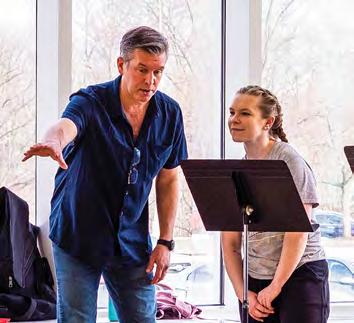

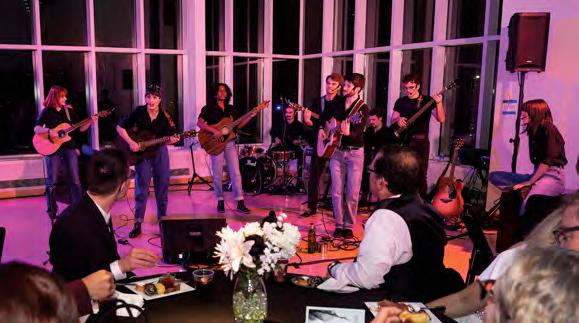
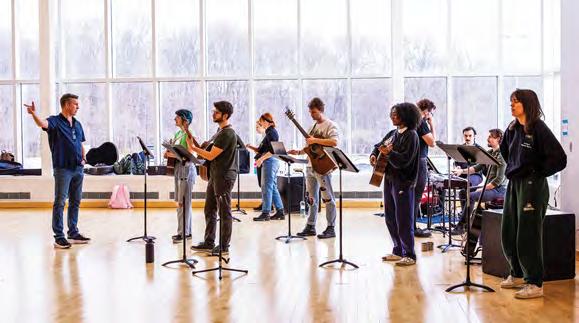

29 WRIGHT.EDU/ALUMNI
Deer emphasizes the work behind the artistic scenes. “Every member of the department is engaged in either crafting a show, choreography, music, or special direction. From Monday to Friday is how long we have to make that happen. Our students learn how to put on a show in that amount of time. Our kids grow hugely from it.
“Saturday afternoon, we do one or two run-throughs to kick it in. Then, Saturday night, the ship sails.”
He added, “It’s one of the most intense entertainment-making experiences we ever do. I think audiences walk into the Creative Arts Center and see how polished it all looks, but they don’t see the energy that goes into making it happen.”
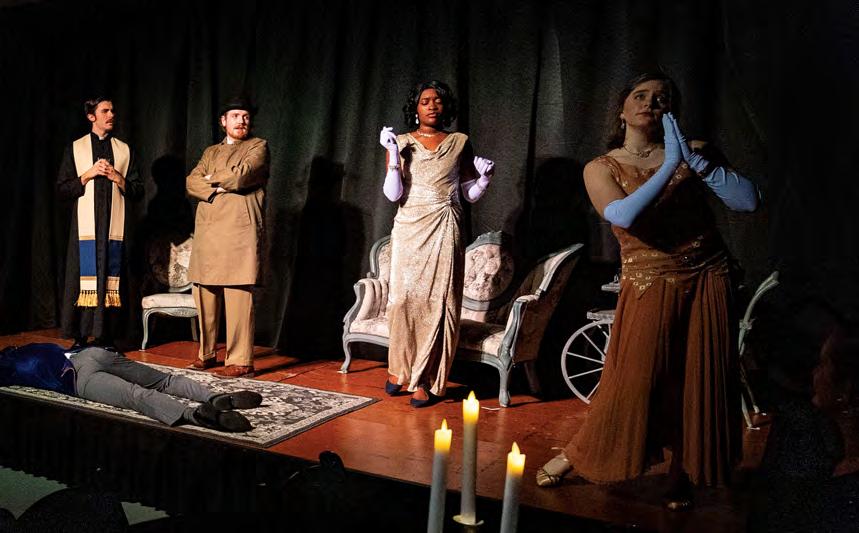
Some of that energy also is on display in the art galleries the day of the event. Tracy Longley-Cook, associate chair of the School of Fine and Performing Arts and associate professor of art, said art students do live painting, engage with patrons, and “offer their expertise on the space.”
“Our students help and work the whole evening. We have photographers photographing the event, painters working off of a model with a costume from the theater, and a printmaker. It’s a fun evening for them as well.”
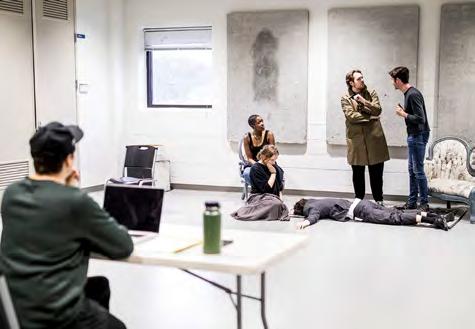
The energy comes from more than artists. “There are volunteers who aren’t performers,” Cordes said. They staff the break rooms and generally keep everyone on track. “And there are stage manager majors who get stage management experience.” The day of ArtsGala is “a big bonding experience,” Cordes said.
Deer said with pride, “Nothing puts as good a face on our institution as ArtsGala. We have success in sports now and then, but this is our Super Bowl every year.”
Offering a historical perspective is Jennie Buckwalter, now a major gifts fundraiser for the Alzheimer’s Association. She played a major role in organizing many past
30 WRIGHT STATE MAGAZINE | FALL 2023
PERFORMANCE AND REHEARSAL OF THE MURDER MYSTERY EXPERIENCE THE MYSTERY AT TWICKNAM VICARAGE BY DAVID IVES.
“ArtsGala has a trifold effect. Most important, it raises money for us to give to students in the form of scholarships every year. The second aspect is that it benefits the university. It allows us to really shine and provide an opportunity for the Wright State community to see all the different things we do. Third, it raises the level of awareness in the region of what we offer here.”
DAN ZEHRINGER, D.M.A. CHAIR, SCHOOL OF FINE AND PERFORMING ARTS
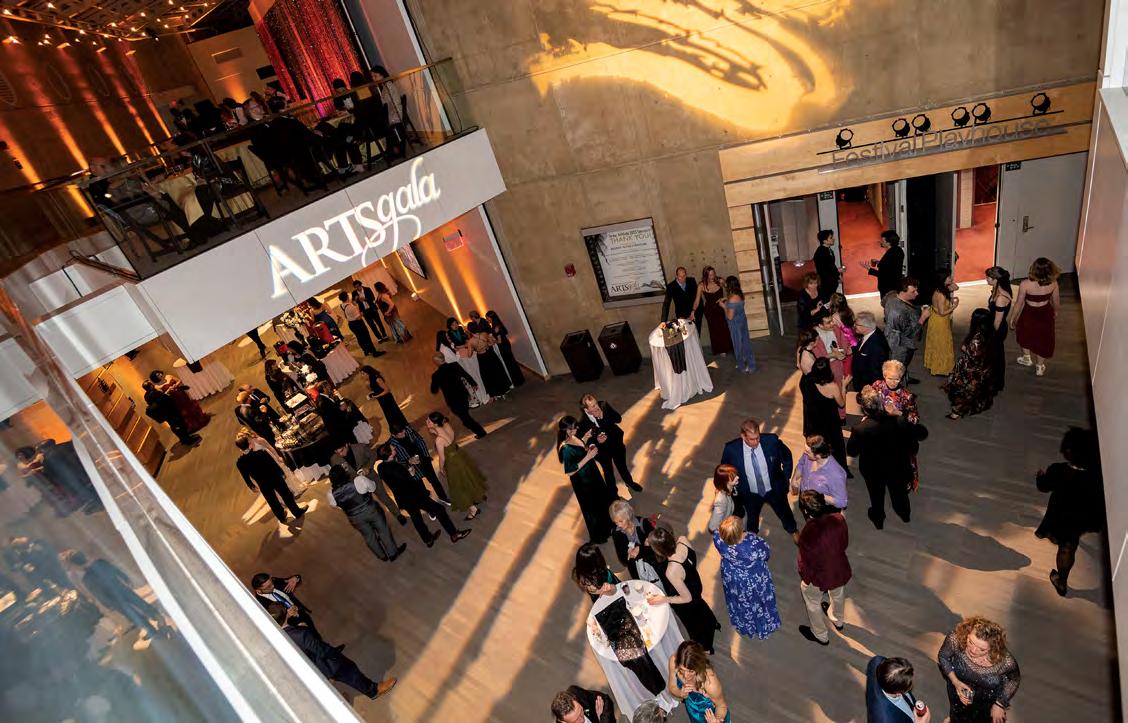
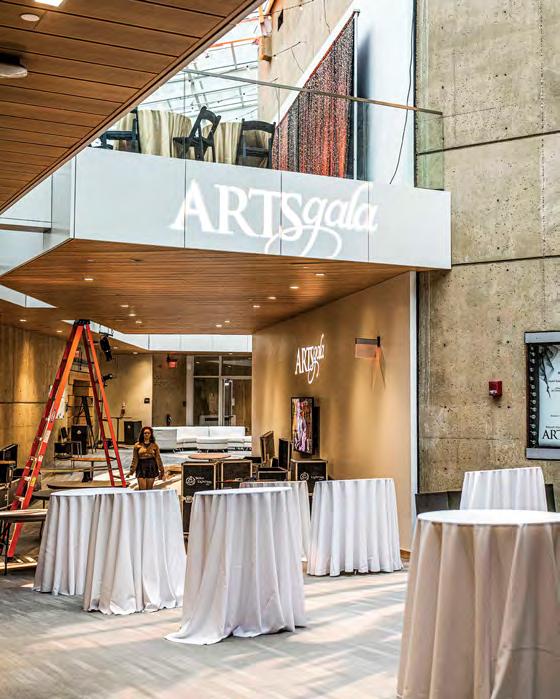
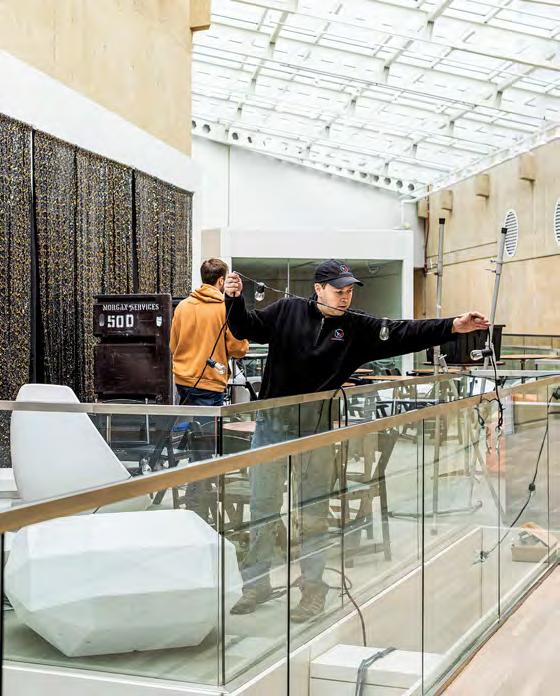
31 WRIGHT.EDU/ALUMNI
ArtsGalas. “This was an endeavor that took all hands on deck, all year long. It required support from faculty, staff, students, alumni donors, community patrons of the arts, and vendors. Top leadership at the university was always supportive.”



Initially, there was a hurdle—getting different people from different arts programs to work as one. “The inception of this was to bring all of these different types of artists and performers and faculty for one grand evening and put our best foot forward to show the arts at Wright State,” Buckwalter said. “It’s not to go unnoticed that all of the arts worked together in such a collaborative fashion. To bring all these experiences together was a feat. It was a leap of faith. But it’s been a success from the get-go.”
The most recent ArtsGala was Buckwalter’s first as a patron instead of an organizer. But the joy and the mission were the same. “My favorite part is getting to meet the students. The driving force behind this whole event is to raise funds for scholarships for these students and
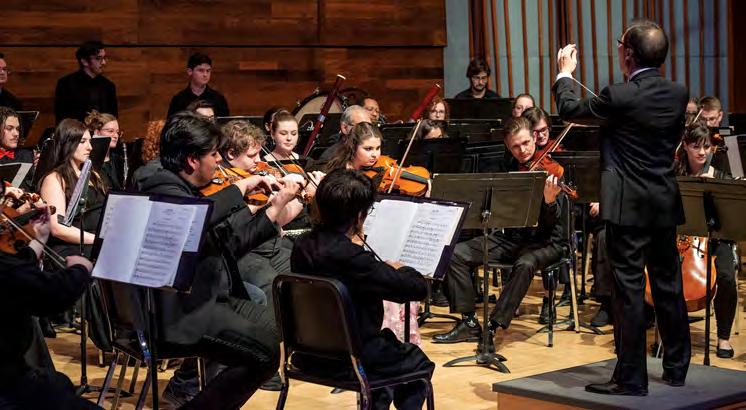
raise awareness of the arts.”
“Scholarship support is important for these students to stay fully enrolled and not have to take a side job to take time away from honing their craft. They’ll get a leg up after graduating with less debt, and not worrying about their finances.”
Referring to the patrons and their effect on the student-artists, Buckwalter said, “Everybody who was in that building was in some capacity telling these students, ‘We believe in you and your success.’ The students get that connection and are humbled by it. Some of them don’t have the support of their families. It’s a challenging path for some. To have hundreds of people show up is meaningful to them.
“We try to highlight all the different talents,” Buckwalter continued. And the dedication. “The hours and hours of rehearsal that students and faculty put into making this a success. There’s choreography specifically for this event. Arts students are painting or sculpting live—you can walk by them. You don’t
CLOCKWISE FROM TOP LEFT: THE CHAMBER ORCHESTRA, UNDER THE DIRECTION OF JACKSON LEUNG, D.M.A., PERFORM THE GADFLY SUITE BY DIMITRI SHOSTAKOVICH; BEN OHNEMUS ’23 (MUSICAL THEATRE) AND TRINITY WOLFF ’23 (MUSICAL THEATRE) PERFORM A SELECTION FROM ON THE TOWN ; STUDENTS FROM THE FINE ARTS PROGRAM PAINT A MODEL; THE MOTION PICTURES PROGRAM AT “PLANET MOPIX ATTACKS!,” A THROWBACK SPECIAL EFFECTS SEQUENCE THAT HONORS 1950S SCIENCE FICTION.
normally get to watch an artist in action. You can see their art evolve.”
Dance major Natalie Nagy of Bellbrook is thankful for how she’s benefitted from a scholarship.
“My ArtsGala scholarship shows me that there are people who believe in my ability to achieve my dreams, and that not only do they believe in me from afar, but they have chosen to invest in my education as an artist. The scholarship has allowed me to attend dance workshops and intensives that encourage me to explore my artistic voice.
“Receiving an ArtsGala scholarship further affirmed me in my decision to study dance at Wright State. It made me feel seen by the faculty and the department, and it gave me confidence that the work I am given the opportunity to do at Wright State is aiding me in my journey to grow as an artist.
“If I would meet the donor who helped fund my scholarship, I would thank them for their support. It is one thing to be a lover of the arts, but to lend the artists of the future a helping hand is a deeper level of involvement. Your support gives me encouragement and hope for my future and the future of the arts!”
The benefit of ArtsGala goes further than one may think. “The impact of this, too, is that many students we are supporting become music teachers locally,” among other creative arts professionals, Buckwalter said. “And these scholarships also help attract other students. Some of our students have gone on to do some pretty remarkable things.”
As an organizer, Buckwalter was part of the post-ArtsGala debriefing. “We wanted to know what went really well, and what we can do better.”
Included in that discussion is the event’s host committee, composed of people in the local arts scene. “We want to know what the community expects,” Buckwalter said.
This year’s committee was led by host couple Jon Blunt and Rodney Veal. “This is the way Wright State connects with the community, to bring people in who can help look at it from the outside,” said Veal, career community coordinator at Sinclair Community College. “Arts education is a vital element to a vital arts community. Wright State is the gold standard.”
Blunt, an interior designer, said he and Veal initially were surprised to have been asked to be the host couple, “but as we discussed it, it made sense because of the background we bring with our connection to the arts community.”
As Veal said, “It was an offer we couldn’t refuse. They want people to know what Wright State is really doing, which is producing exceptional students to perform on Broadway and on TV and in the film industry. They win awards, which means Wright State is doing something right. It’s not an easy thing to produce art of that caliber.”
Veal added, “The great thing about ArtsGala is that if you’ve never seen a dance production or a concert, you can get a taste of it. You realize your money is going to building a future in the arts, and how wonderful that is. It’s a win-win scenario. And it’s for a great purpose: scholarships. Some students say this made the difference, that they chose Wright State because of the aid.”
Attesting to its winning scenario is Buckwalter. “This is a fun night and great night but with a purpose behind it: Funding critical scholarships for our students to succeed.”
To learn more about ArtsGala, please visit wright.edu/artsgala . Donations to the ArtsGala scholarship fund can be made at wright.edu/give/artsgalaschl
Vicki, this ArtsGala is for you
It can be said that every ArtsGala is special, but the most recent one was more so. That’s because it was the last one for Vicki Oleen, who is retiring after 48 years with Wright State.

As managing director in the School of Fine and Performing Arts, Oleen played a large role in making every ArtsGala happen since its inception in 2000. So much so that the recent event was dedicated to her. At ArtsGala’s opening ceremony, she was presented with a bouquet of flowers and a bouquet of praise.
She first became involved when the art, music, and theatre, dance, and motion picture departments prepared to stage the inaugural event. “I was asked to work with everyone to coordinate—it was the first time we transformed the Creative Arts Center into an entertainment venue. I then did it every year. I love ArtsGala.”
Oleen continued, “There’s something special about everyone coming together and working together, especially in the week before. It’s good for the students to have the opportunity of putting together a show with short rehearsals.”
She shares the success with students who helped her. “I’ve always had student stage managers. Without them it would be difficult. For them, it’s about event planning in addition to stage managing. It’s part of their education without them being in a classroom.”
Anna Hunter, a theatre design technology major concentrating on stage management and property art, helped Oleen during the 2022 and 2023 ArtsGalas. “She’s fantastic about letting students take the lead and supporting them when they need it,” Hunter said. “I adore Vicki. She’s a wonderful, wonderful woman. It’s been an incredible learning experience that I wouldn’t necessarily have received in a lot of other places.”
As for Oleen retiring, Hunter said, “A piece of my heart will go with her.”
33 WRIGHT.EDU/ALUMNI
Wright State students go to Italy
 BY SARAH CAVENDER ’20
BY SARAH CAVENDER ’20
THE WRIGHT STATE ART HISTORY PROGRAM PARTNERED WITH THE PHOTOGRAPHY PROGRAM IN THE SUMMER OF 2022 FOR AN UNFORGETTABLE EXPERIENCE FOR STUDENTS STUDYING ABROAD.
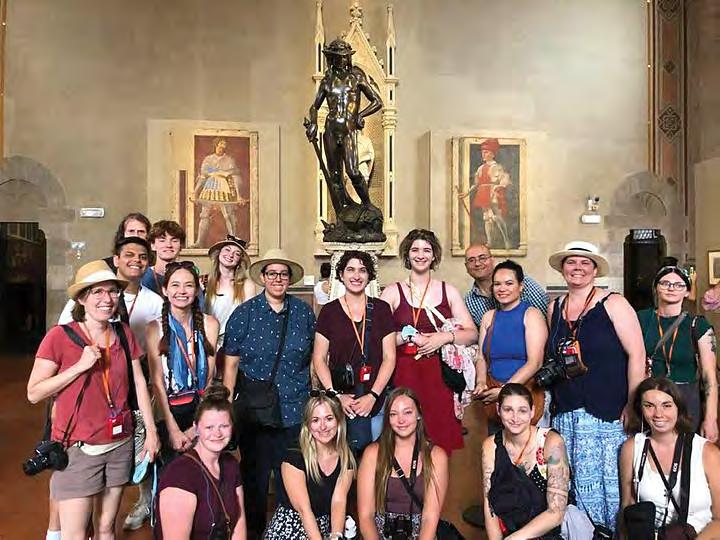
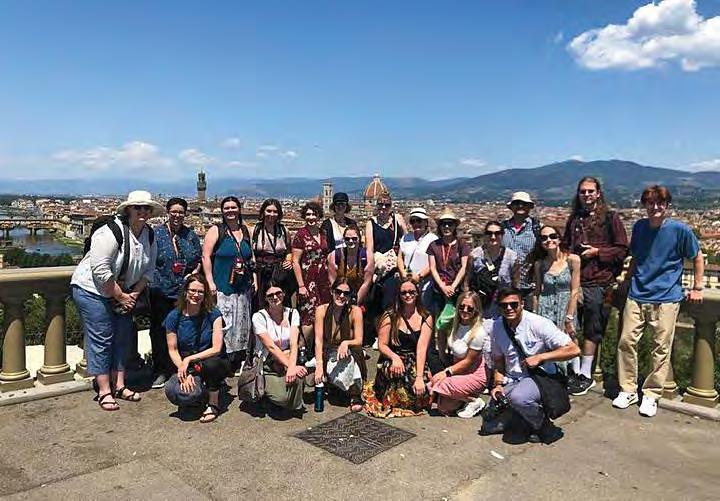
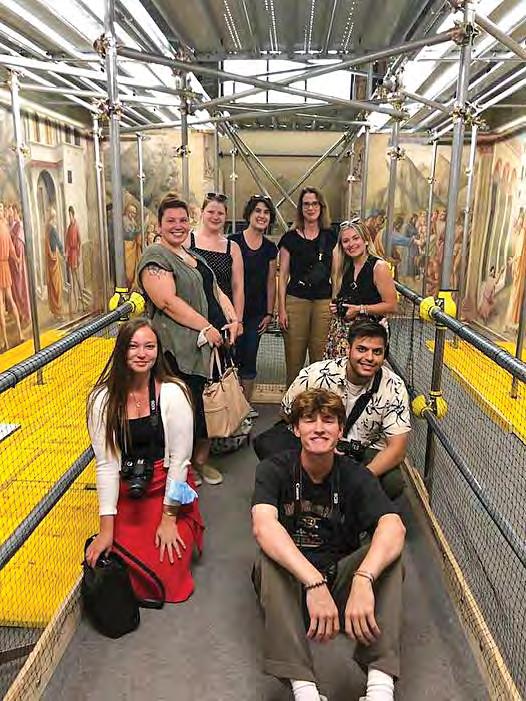

Led by Caroline Hillard, Ph.D., associate professor of art history, and Tracy Longley-Cook, associate chair of the School of Fine and Performing Arts and associate professor of art, this was the first time the two programs created an opportunity for students from both to earn credits.
Seventeen students attended the three-week-long trip, where they stayed in Florence, Italy, and Rome.
“ The Italy program that I went on in July was the last class that I needed to graduate,” Kara Thornbury said. “It was a really great end to the four and a half years it took me to get my Bachelor of Fine Arts.” Thornbury also minored in French and attended the France trip in 2019.

Throughout the trip, students completed either photo assignments or short writing assignments, based on the course they were enrolled in. During the weekends, students could explore on their own and visit the beaches and shops—and try to sightsee on an iconic Italian motor vehicle.
One unique experience was a scaffolding tour of the frescoes in Brancacci Chapel, a church in Florence, painted by artists Masaccio and Masolino in the 1400s.
“ The artist Masaccio is regarded as the first Renaissance painter, the founder of the Renaissance style,” Hillard said. “We teach about him in all the introductory art history classes. He painted this series of frescoes, or these wall paintings in a chapel, and we have visited that chapel on previous trips.”
“However, on this particular trip, the chapel was about to undergo restoration. They had scaffolding set up in the chapel, and they were allowing a limited number of visitors to climb the scaffolding to get up close as opposed to just seeing them from the ground.”
For many students, this was their first experience in Italy. For Longley-Cook, it was one of her favorite parts about studying abroad. “I think witnessing the students sort of go through those life-changing experiences, for me was probably, I hate to sound cheesy, but it was really one of the top elements.”
There are no immediate plans for a return to Italy, but according to Hillard, it is hoped there will be an Italy trip in summer 2025.
The trips are available to all students, not just those in the creative arts. “I worked in study abroad even before I came to Wright State,” Hillard said. “I witnessed myself how it changes people’s lives, and it’s completely different, if all you’ve known is Ohio, and now you’re suddenly in a place where the food is different and everything looks different.”
RAIDER OPEN HOUSE
SATURDAY, OCTOBER 21
We know Wright State University means a lot to you. It’s the years you spent making lifelong friends, starting college traditions, and setting the stage for where you are now. We’re proud that our alumni are the strongest legacy of Wright State.
You can help high school students who are just like you were before coming to Wright State. Do you know a high school student looking at universities? Tell them they’re invited to the Wright State Raider Open House.

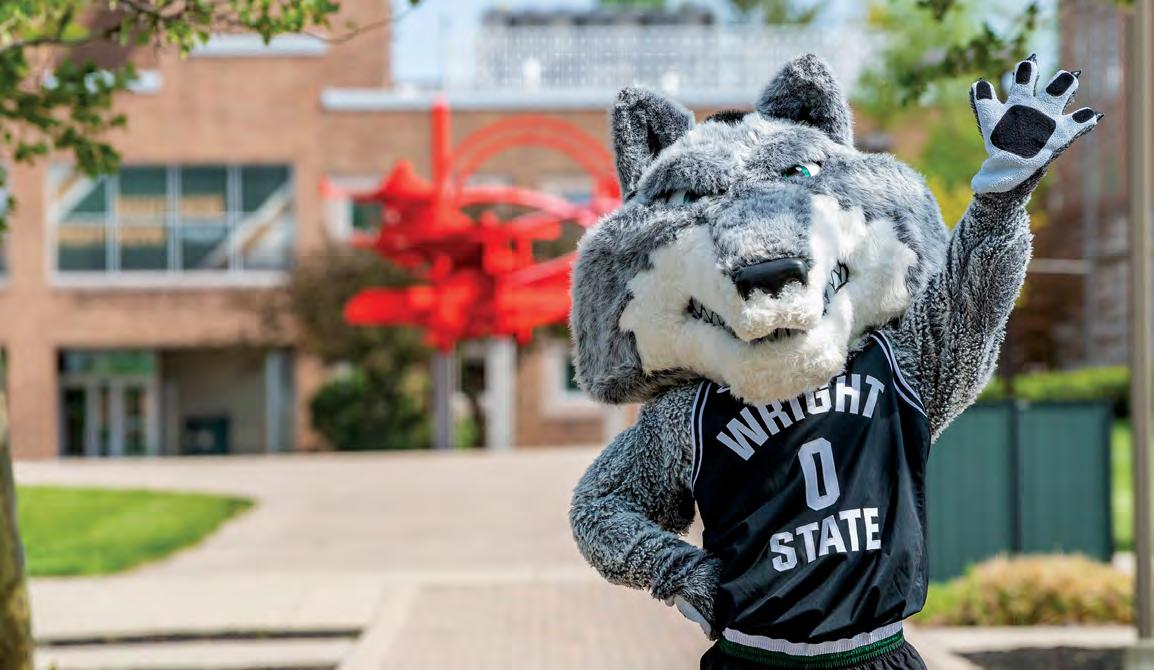
GET A GLIMPSE OF WHAT IT’S LIKE TO BE A RAIDER!
During Raider Open House students can: Explore new possibilities by connecting with faculty, staff, and students.
Examine the academic programs and support services that will help them achieve their dreams. Experience Raider life on a tour of campus and check out student life opportunities.
wright.edu/RaiderOpenHouse
CAN’T MAKE IT OCTOBER 21? PLAN FOR A FUTURE DATE: MARCH 9, 2024
The Wright State Alumni Association offers fun and educational tours with unique itineraries exclusively to our Wright State family (alumni, friends, faculty, staff, and retirees).
Ready to book your trip or have a question? Contact us at 800-842-9023 or visit: wrightstatealumni.com/events/travel-tours


 Caribbean & Panama Canal February 26–March 7, 2024
Marvelous Mediterranean May 15–25, 2024
Caribbean & Panama Canal February 26–March 7, 2024
Marvelous Mediterranean May 15–25, 2024
A CONTEMPORARY CUPPA
Many say it is a beautiful thing when a plan comes together. For Mindy Hoffbauer ’97, ’99, this entailed collaborating with her family to bring a longtime dream to fruition.
Hoffbauer envisioned owning her own business for years. Her husband, Greg, was seeking another venture in retirement, and her son, Andy, a college student, was struggling to identify his passion. She had always loved coffee, and her son shared this interest.

After more than a year of planning, Hoffbauer, a two-time graduate of Wright State, and Andy opened ContempoRoast in Centerville. The coffee shop values sustainability and education while focusing on a modern approach.
Mindy Hoffbauer earned a bachelor’s degree and a master’s degree in English from Wright State in 1997 and 1999, respectively. Her background in technical writing








What could our graduate programs do for your future?

and communication is a fit for spearheading the business’ marketing, website, and social media efforts.





Hoffbauer credits her Wright State experience for preparing her to be a business owner. As a student, she discovered her true passions were technical writing and owning a business. She said Wright State allowed her to customize a program that steered her in the right direction.
“Carol Loranger was one of my favorite professors, and she granted my request to develop a website. That gave me real-world experience because I was interested in technical writing,” Hoffbauer said. “I also took an M.B.A. course because I wanted to start my own business as a technical writing consultant. That freedom to personalize my curriculum was fantastic. The critical thinking skills that I acquired there have served me well throughout my career.”
wright.edu/grad
A doll for every child
Lisa Williams ’86, ’88 creates multicultural dolls that represent all children
 BY KIM PATTON
BY KIM PATTON
As she sat down to rest her mind and watch television one Saturday, Lisa Williams, Ph.D., had no idea her life would change forever.
A CNN program hosted by Anderson Cooper about an updated doll study quickly captured her attention.
In previous doll studies conducted in the
1950s and 1960s, children were given the choice of whether they wanted to play with a Black or white doll. All the children— whether they were Black or white—chose to play with the white doll.
When a young Black girl was asked during the updated study which of the dolls she wanted to play with, Williams was certain that a Black child living in 21st-century America would choose a Black doll.
“Shockingly, she didn’t want to play with the Black doll. But what broke my heart was when she explained why,” Williams
recalled. “She said the Black doll’s skin tone was ‘nasty.’ Then she touched her own hand and said ‘nasty.’”
After she stopped crying, Williams thought to herself, “You cannot allow this to happen. You cannot allow a generation of girls to grow up thinking they are less than beautiful.”
FROM HIGHER EDUCATION TO THE TOY INDUSTRY
When Williams was shattered at the sight of a little Black girl describing the color of her skin as “nasty,” she was at the height of her career in the world of academia.
A two-time graduate of Wright State University—where she earned a Bachelor of Science in Business and an M.B.A.— Williams went on to graduate with a Ph.D. in supply chain management from The Ohio State University.
At Ohio State, she was the first African American to earn a Ph.D. in her field.
38 WRIGHT STATE MAGAZINE | FALL 2023
“I didn’t plan to be a pioneer,” said Williams, “but I had all of the confidence that I needed to do that, because of the wonderful experience that I had at Wright State.”
Williams went on to become the first female professor to receive a multimillion-dollar endowed chair and the first African American professor to earn tenure at Penn State University. She was also the recipient of two multi-million-dollar endowments for her research in supply chain and logistics.
“I was happy as a professor,” she recalled. “I loved teaching. I loved conducting research studies with students. I had a global reputation for my research. Life was amazingly good.”
But that haunting image of the little Black girl on television also dovetailed with her own experiences as a college professor. In her classroom, Williams saw brilliant young women who would not speak up.
“ They would come to my office hours, and I knew by talking to them that they knew the answer. It was a self-esteem issue,” she explained.
When she saw the young girl on Anderson Cooper’s program, Williams realized those self-esteem issues start in childhood.
“I knew I had to do something,” she said. “It was a very tough decision to leave, but I felt a deeper calling to help little girls and
adult women with seeing who they really are—their beauty, their brilliance, how amazing they are.”
Transitioning from the comfort of her classroom to the unknown world of the toy and doll industry was no easy task for Williams. She had no experience, no money, no connections, and no encouragement as she founded her own doll company.
“People thought I had lost my mind,” recalled Williams, who admitted to making mistakes early on. “As I learned, I made better decisions. As I made better decisions, the company grew and thrived.”
Williams also realized that her lack of education in the toy industry was her greatest strength. She could think creatively and differently. And she could make sure her dolls were truly authentic and representative of cultures from around the globe.
Since founding the World of Entertainment, Publishing, and Inspiration (World of EPI) in 2003, Williams’ attention to detail remains unchanged. Her company has created patent-pending hair, developed custom-blended skin tones, and sculpted faces that mirror the people they represent.
“Everything is intentional and has to be authentic,” said Williams. “Everything we do centers around satisfying a need—a need to make sure that there is representation for all children.”
When she first launched her company,
Williams brought two dolls to the marketplace. Twenty years later, the World of EPI now produces multiple product lines—for both girls and boys—as well as licensed products with Disney and Marvel. Their Black Panther collection won the highly coveted and competitive Toy of the Year award in the Doll Category.
While she is proud of and grateful for the accolades, Williams says the most significant and most heartwarming recognition comes when a child spots a World of EPI doll on a retailer’s shelf, runs right to it and exclaims, “Mommy, the doll looks just like me!”
“ That’s what gets me up every morning,” said Williams. “I hope that when a child plays with one of our dolls, they begin to dream beyond their current circumstances. I want them to see their faraway dreams as realities.”
For Williams, there is no better job than bringing joy and happiness to the faces of children and empowering and inspiring them to be their best.
Her greatest hope is that the children playing with World of EPI dolls today will one day pass along those dolls to their own children and grandchildren, so the cycle of empowerment continues for future generations.
“It all started,” said Williams, “by seeing that little girl on television and letting nothing dissuade me from getting it done.”
39 WRIGHT.EDU/ALUMNI
“I didn’t plan to be a pioneer, but I had all of the confidence that I needed to do that, because of the wonderful experience that I had at Wright State.”
LISA WILLIAMS ’86, ’88
FUN FOR ALL AGES

Whether you are a recent graduate, a part of our GradX Alumni Society, or a seasoned Alumni Achievement Award winner, the Wright State Alumni Association has something for everyone. Not only do we put the fun in fundraising with our legacy golf outing, we volunteer for local community organizations and get together to have a little fun in the rain or at the game! Have you visited our events calendar lately?


SEE YOU AT OUR NEXT EVENT

Visit wrightstatealumni.com/events for more information on how you can join the fun.


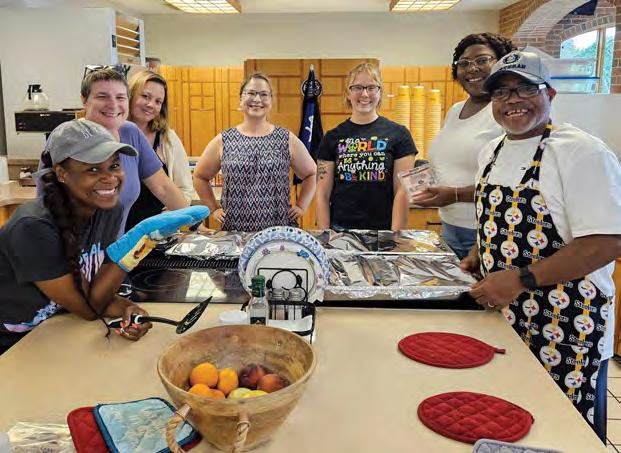
40 WRIGHT STATE MAGAZINE | FALL 2023
KINGS ISLAND DAY
SOCIAL WORK ALUMNI SOCIETY VOLUNTEERING AT RONALD MCDONALD HOUSE
GRADX NIGHT AT DAYTON DRAGONS GAME
LEGACY SCHOLARSHIP GOLF OUTING



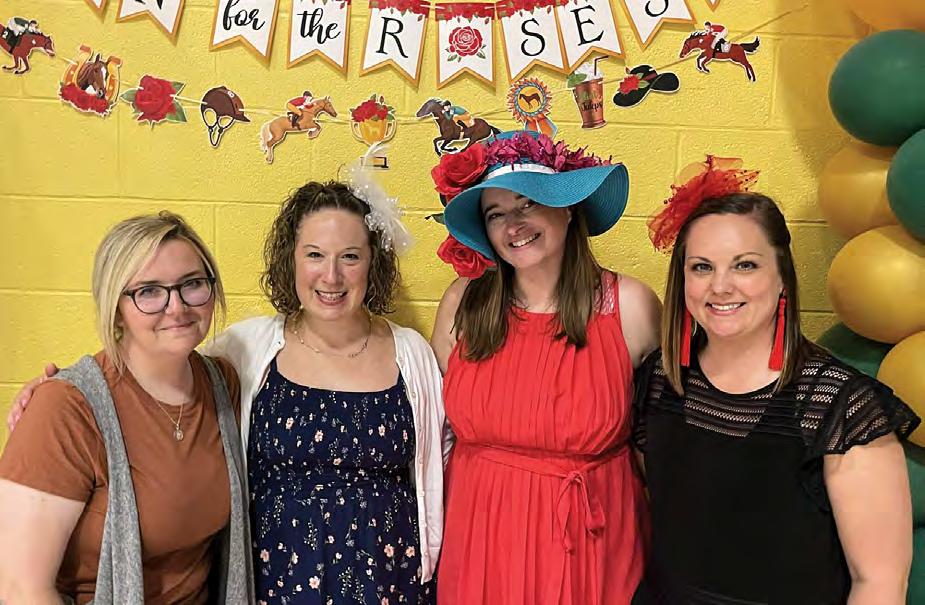

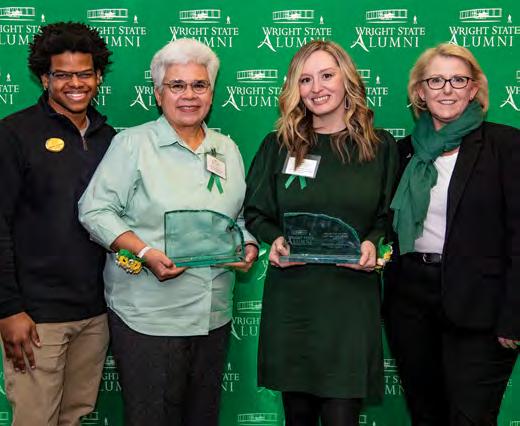
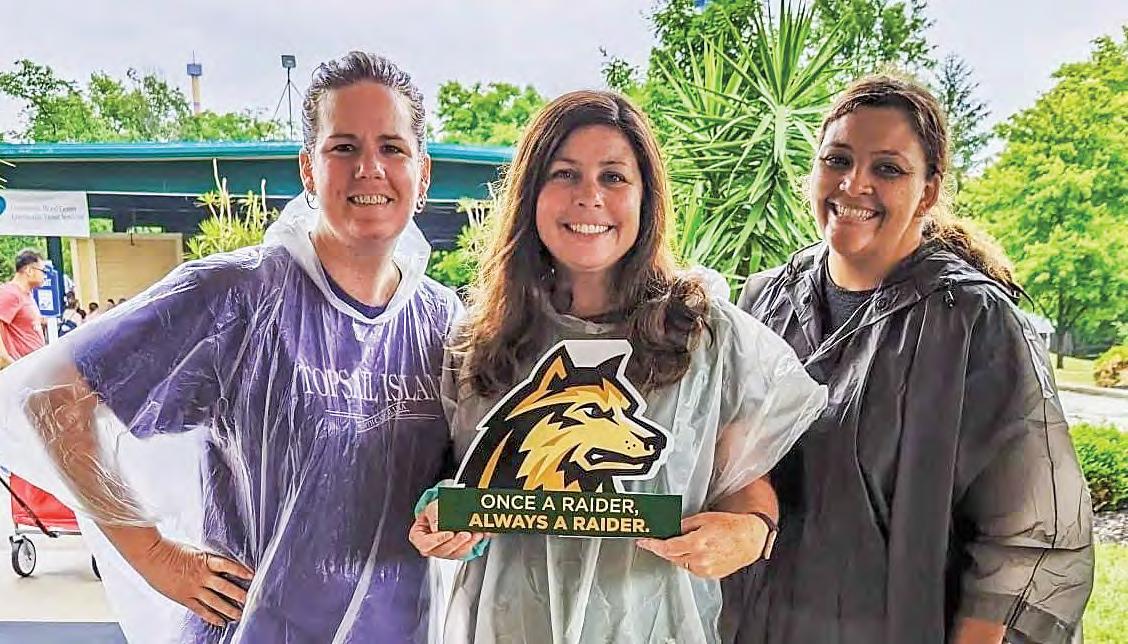
41 WRIGHT.EDU/ALUMNI
ROWDY NIGHT AT THE RACES
SPRING GRAD FEST
SPRING ALUMNI SERVICE DAY
KINGS ISLAND DAY
LEGACY SCHOLARSHIP GOLF OUTING
GRADX NIGHT AT DAYTON DRAGONS GAME
2023 ALUMNI ACHIEVEMENT AWARDS
2010s
Brandi Howard ’13
2000s
Paula Buchholz ’09
Stacy Heitkamp ’01
Taryn Jones ’00
1990s
Charles Davis ’95
Christopher Decker ’97
Michele Elliott ’93
Marilyn Hart ’90
Gary Pollock ’97
Barbara Roberts ’93
Uta Schenck ’91
Robert Stewart ’95
Vicki Wartner ’95
Neoma Young ’90
1980s
Dana Blommel ’83
Barry Brown ’83
Virginia Denison ’87
Joan Enouen ’87
Kathleen Falkowski ’87
Charles Hall ’89
Scott Holmes ’88
Tracy Johnston ’89
Scott King ’83
Daniel Kleinman ’82
Priscilla Landreth ’88
Michael Ludwick ’85
Debra Maurer-Brown ’89
Colleen McCarthy ’83
Susan Miracle ’84
Joyce Price ’83
Thais Reiff ’81
Joseph Sens ’82
Lynda Troy ’89
Hershel Wright ’81
Karen Yocom ’89
1970s
Lavonne Ahrns ’72
Anita Bartlett ’73
Linda Bell ’75
Eunice Bronkar ’71
Anne Brubaker ’78
Duane Burkholder ’76
Robert Eddy ’76
Virginia Edwards ’77
Deanna Ewers ’74
Marvin Fox ’71
Marcia Frank ’78
Norwood Golden ’72
Thomas Kerschner ’77
Gerald Matthews ’77
William Mattingly ’71
Mark Mattix ’79
Barbara Meade ’74
Annetta Mikolanis ’74
Nancy Paessun ’74
Thomas Rouse ’76
Gloria Schwartz ’74
Charles Tyler ’74
1960s
Thomas Apple ’68
Norma Bicknell ’69
Francis Keana ’69
FACULTY AND STAFF
Robert Darrow, Ph.D., ’05
Bonnie L. Davison
Tran Dung, Ph.D.
Helen Gail
Altman Klein, Ph.D.
Gerald McLaughlin ’90
Michael Montag ’75
Barbara O’Brien
Charles “Charlie”
V. Painter ’74
Sarah Selkirk
Timmons, M.L.S.
Edward Trentman
Pamela K. “Pam” Wheeler
We rely on family and newspaper obituaries to inform us of the passing of Wright State alumni, faculty, staff, and retirees. This list was compiled between February and June 2023. Please send all death notices to alumni_news@ wright.edu
ARTIST, SCULPTOR, AND FRIEND OF THE UNIVERSITY
Virginia Krause Hess
Prolific Daytonian artist and sculptor Virginia Krause Hess, whose work can be found across the Dayton region and around the world, passed away May 9. She was 98. Her long list of accomplishments includes civilian service at Wright-Patterson Air Force Base, where, at 17 years old during World War II, she painted silhouettes of planes. Her silhouettes were printed in books and on posters, charts, and playing cards to help soldiers identify the shadows of friendly aircraft so they wouldn’t shoot down their own planes. She also used her salary from Wright-Patterson to pay for flying lessons.
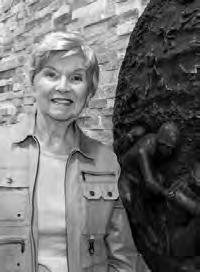
Hess’ sculptures are on display at Dayton Children’s Hospital, Dave Hall Plaza in downtown Dayton, and Wright State University. Her five bronze medallions depicting military personnel in the Air Force, Army, Marines, Navy, and Coast Guard are featured outside Wright State’s Veteran and Military Center. She also sculpted the bronze Veterans Monument display at Stubbs Park in Centerville.
She sculpted a bronze bust of Charles E. Taylor, the Wright brothers’ mechanic and creator of the engine that enabled Orville and Wilbur Wright to achieve controlled powered flight. The bust has become the basis for the Charlie Taylor Award given to aircraft mechanics for a 25year perfect record, one of the most prestigious accolades in the field. Hess produced greeting cards and worked for foundries and a bronzedshoe company. She also taught art at the Dayton Art Institute, the Art Academy in Cincinnati, and the Springfield Art Center.
She is survived by her children, Peter Hess, Kristina Hess, and Victoria (Hess) Bender.
Her son, Peter Hess, attended Wright State and worked for the university as a photographer in the 1970s. Her daughter, Kris, graduated from Wright State with her bachelor’s degree in education. Hess’ husband, who died in 2006, donated his body to the anatomical gift program at the Boonshoft School of Medicine.
Hess served on Wright State’s Friends of the Libraries board, which supports the University Libraries’ collections and programs. She also received the Wright State Alumni Association’s Honorary Alumni Award in 2023.
“It’s an entirely different feeling here than any other university I’ve worked with,” Hess said. “There’s a feeling of compassion and friendship and caring here that you don’t feel at any other university. They’re so interested in helping everybody.”
In lieu of flowers, the Hess family asks that everyone purchase and enjoy some good art or donate in her name to the Dayton Art Institute, the Springfield Museum of Art, the Rosewood Arts Center through the Kettering Parks Foundation, or Wright State University.
42 WRIGHT STATE MAGAZINE | FALL 2023
FAREWELLS



43 WRIGHT.EDU/ALUMNI Give back to the PACK! Scan Now to Give! OCT 3 wright.edu/wrightday2give SAVE THE DATE!
RAIDER EVENTS
Sapphire Jubilee
The African American Alumni Society is proud to present the Sapphire Jubilee to recognize the contributions of Black alumni, students, faculty, and staff.

Amigos Latinos Gala
The Amigos Latinos Gala helps support the mission and work of the Latino Center at Wright State University.

Wright Day to Give
Join us to honor our Founder’s Day, October 3, as we celebrate our seventh annual 24-hour giving challenge with alumni and friends.
Fall Alumni Service Day
Alumni Service Day is an opportunity for our alumni, friends, and family to give back to the community and further Wright State’s longstanding tradition of community service.

For more information and to get tickets for upcoming events, visit wrightstatealumni.com/events .
OCTOBER 10–20
Radiant Spring & Italy
OCTOBER 21
Raider Open House
NOVEMBER 16
Lake Campus Open House
DECEMBER 9
Last day of fall classes
DECEMBER 15–16
Fall Commencement
JANUARY 8, 2024
First day of spring classes
FEBRUARY 26–MARCH 7, 2024
Taste of the Caribbean & Panama Canal
MAY 15–25, 2024
Marvelous Mediterranean
44 WRIGHT STATE MAGAZINE | FALL 2023
OCT 7 OCT 3 NOV 11
SEPT 23
’67
WILLIS “BING” DAVIS (M.E d .) is the subject of a PBS documentary coming in 2024 for his cultural contributions and activism.
’76
STEVE PULLINS (B.S.) has joined the Xendee Corporation of La Jolla, CA, on its Board of Advisors.
’77
DING-JO CURRIE (M.S.) was honored with the Leadership Award and inducted into the Leadership Hall of Fame by the American Association of Community Colleges for her work at Cal State Fullerton, CA. EDWARD GIBBONS (M.E d .) has been inducted into the Fairborn City Schools Hall of Honor for his work in the school district.
’78
ANDREW BALDWIN (B.A.) is an adventure writer of the Wyoming wilderness in his Relic Series, including a new book, Antidote CHITRA DIVAKARUNI (M.A.) has released her latest book, Independence, which tells the story of India’s independence through the eyes of three sisters. DON DONNETT (M.M.) is retiring from the Dayton Philharmonic Orchestra after 61 years as its principal timpanist.
’79 TOM DINGUS (B.S.) has earned the U.S. Government Award for Safety Engineering Excellence.
’82
SHARON SHORT (B.A.) was a guest of WYSO’s Book Nook , discussing her latest book The Widows
CLASS NOTES
85th House District (Champaign County, Shelby County, and southern Logan County). BRIAN CROWE (B.F.A.) will be The Shakespeare Theatre of New Jersey’s new artistic director as of January 2024.
’95 SCOTT GEISEL (B.A.) has written and published a new mystery novel, Miller Knew, set in the hills of Appalachian Virginia. CARRIE HALL (B.S.N.) has been inducted into
JONATHAN M c NEAL ’96
the National Academies of Practice as a Distinguished Fellow in the Nursing Academy.
’96 SHANE HARDY (M.B.A.) has been named chief operations officer for Mercy Health, Springfield Medical Group, Springfield, OH.
’97 MELINDA GILMORE (B.A.) has been promoted to director of communications
’84
DOUG CRAIG (P sy.D.) has been nominated for Underground Good for his work about climate change, in Shasta County, CA.
LAURA HUGHES WYNIA (B.S.E d .) was awarded the 2023 Ohio Nationally Certified Music Teacher of the Year.
’85
MICHAEL WILLIAMS (B.A.) has been inducted into the Marquis Who’s Who Biographical Registry for his leadership of The Kitchen Flavors, LLC, of San Antonio, TX.
’87 RICHARD JENNINGS (M.S.) is a nonresident fellow in the Baker Institute Space Policy Program and a clinical professor in space medicine at the University of Texas Medical Branch.
’91 MARK BROWNE (M.D.) is senior vice president and chief medical officer of Covenant Health, Knoxville, TN.
’93 TIM BARHORST (B.S.B.) is a first-term Representative in the Ohio House for the
Jonathan McNeal has parlayed his 1996 degree in motion picture production into a career now in its 22nd year of being manager of The Neon, the independent movie theater in downtown Dayton.

A fter graduating from Wright State, McNeal became a manager in the retail world, which made him a good fit to be a manager of The Neon when the position opened a few years later.
S ince the pandemic, many small businesses have been struggling to recover. Theaters are no exception. McNeal spends his days keeping the theater operating. The pandemic caused the theater to temporarily close; ticket sales were lower than ever.
F or McNeal, it began like this. As a Dayton native, he found himself at Wright State because of the affordable cost of the school and the opportunities the motion picture program offered. McNeal said he had his mind set on motion pictures and Wright State in the eighth or ninth grade because of his fascination with how motion pictures are made and the proximity of the school.
W hen asked why he would encourage others to attend Wright State’s motion picture program, his response was definitive. “A lot has changed over the years and how the program is run...but certainly in my time it was a very nurturing program. By the time you got to the junior or senior year, you got a lot of hands-on, one-on-one time that was [with] award-winning, Oscar-nominated artists with great bodies of work.”
He added, “By the time you came out of the program, you had a portfolio like someone out of a prestigious grad school.”
McNeal noted that it was because of Wright State and its motion picture program that he was able to “get my feet wet in production.” McNeal also said the program “offered me a jumpstart in understanding and being able to grasp what it took to put on programs.”
His advice for others going into the motion picture industry is, “There’s always work but it’s always a hustle. The work is out there, but it’s not always in your backyard.”
He added that his job is a little different than the normal trajectory students hope to get in film. Yet, it is rewarding and a job valued by the community when done well.
A s a filmmaker, McNeal made a documentary on the Rubi Girls, a comedic drag troupe. This documentary has helped the group grow throughout the years and has helped promote cultural sensitivity. He predicts it will come in handy to help combat legislation against the drag community.
Today, McNeal spends his time “getting our audience back” at The Neon. McNeal says some days he “spends as little as six hours in the theater, other days it’s 10-hour days.”
He added that he uses film “as the ultimate life form that it is and to rally the community to make things better.”
45 WRIGHT.EDU/ALUMNI
RENIKA WILLIAMS ’15
As a student at Stivers School for the Arts, Renika Williams began acting in school plays at age 12. As she fell in love with performing, she asked her father, “Can I do this when I grow up?” He replied, “You can do whatever you want to do.”
Just as Williams’ father inspired her to pursue her dreams, he also encouraged her to audition for Wright State’s theatre program. When she received a generous scholarship from Wright State, going to college in her hometown became too good of an opportunity to pass up.
“ I’m glad I chose Wright State because of the education I got there,” said Williams. “The great thing about Wright State’s professional training program is that it’s rigorous but intimate. You get to know your instructors, and you feel comfortable with them. You grow as an artist and as an adult.”
A fter graduation, Williams interned for a year at Cincinnati Playhouse in the Park before heading to New York City, where she landed various roles in live theatre productions.
“ Doing theatre introduced me to a whole new world of people and storytelling,” said Williams, who has since transitioned to performing in front of a camera for the role of Willow in The Sex Lives of College Girls on HBO Max.

“ From day one, I thought it was really funny. When I got the script, it stood out to me,” she recalled. “Willow is bold and charismatic. She’s an opinionated person who is not afraid of expressing how she feels. I love that about Willow, and that’s what attracted me to the character.”
Portraying Willow has also given Williams the good fortune of working with the show’s co-creator, Mindy Kaling.
“ Mindy is a powerhouse, but she’s also really warm. She’s very intentional about what she writes, the people she works with, and the stories that she wants to tell to continue to move the art form forward. I really love that about her,” said Williams. “She’s definitely become a mentor.”
manager of Carlisle, OH. ROBERT MCRAE (B.S.) has been promoted to chief operation officer of Palisade Bio, Inc., of Carlsbad, CA. ADAM PUTHOFF (B.S.E d .) has been hired as the St. Henry, OH, School District superintendent.
’07
MONICA MORALES MASIS (M.S.) is a professor at the University of Twente in the Netherlands, working with her research group on the development of electro-optic materials.
’08
RICK BAILEY (B.S.) has been named the chief customer experience and mobility officer for the Toledo Area Regional Transit Authority. KATRINA BRUMFIELD (B.S.E d .) has received the Excellence in Teaching award from Clark County, OH. ERRIK HOOD (B.M.) is a music assistant professor of voice performance at NYU Steinhardt and performs as baritone in operatic and concert realms.
’10
ALLISON BOOT (B.A.) has been named Ms. Wheelchair Ohio for 2023. ANGELA KING (B.S.) is a first-term Representative in the Ohio House for the 84th House District (Mercer County, northern Darke County, and southern Auglaize County). JOHN MIDDENDORF (B.S.) has been named director of the Ohio State University Center for Design and Manufacturing Excellence additive manufacturing division.
at the Charles F. Kettering Foundation in Dayton. MINDY HOFFBAUER (B.A.) has opened a coffee shop and roastery in Centerville with her son Andy. TABATHA RIEGLER (M.A.) has been promoted to vice president of sales and marketing at Ameritas of Lincoln, NE. DANIELLE ROLFES (B.S.) has been named partner-in-charge of the Washington National Tax practice of KPMG LLP, New York, NY.
’98
FLAVIUS LILLY (B.S.) has been named provost at McDaniel College, Westminister, MD.
’99
JEFFREY KOVACIC (M.D.) has been named one of Georgia Trend’s 2023 Top Doctors for pediatric orthopedics. JESSE
LIGHTLE (B.S.) has accepted the position of Liberty Township, OH, administrator.
’00
KATHERIN NOLTE (B.A.) has written a novel, Back to the Bright Before, for middle grade readers.
’05
JOANNE GILLEY (M.E d .) has received the Excellence in Teaching award from Clark County, OH.
’11 DANIELLE LIEBER (B.A.) has written another fantasy novel, Intended Bondmates. JOHNATHAN MOORE (B.A.) has been awarded the Meritorious Service Medal for his accomplishments as Company Commander with the Ohio Army National Guard. TERRA FOX WILLIAMS (M.P.H.) has been named president and CEO of Dayton’s YWCA.
’12
RHEA ADKINS (B.A.) was selected to be on Top Vegan in April 2023 and has written Beginner’s Plant Based Jumpstart for those looking to start a plant-based journey.
’06
RAMESH BASNYAT (M.S.) is currently vice president of consumer and small business banking with Bank of America. RONALD COTHRAN (M.E d .) has been selected interim commissioner for District 8 of Shreveport, LA. CHRIS LOHR (B.A.) has been appointed city
’13
SEAN KELLEY (M.A.) has been inducted into Fairborn City Schools Hall of Honor for his work at North Central College in Naperville, IL, as associate professor of music and director of athletic bands. KYLE OTT (M.D.) has joined the Adena Orthopedic and Spine Institute at Adena Fayette Medical Center in Washington Court House, OH. JOSHUA SMITH (B.S.) has been named to the Xenia Community School Board of Education.
’14
DANIEL WILLIS (B.S.B.) is the audiovisual archivist for the Ohio History Connection in Columbus.
46 WRIGHT STATE MAGAZINE | FALL 2023
Update your information with the Alumni Association to receive the monthly Alumni Insider e-newsletter, full of events, athletics updates, and university news. Visit wrightstatealumni.com/updatemyinfo to add updated information.
’15
ANGIE KING (M.B.A.) has been elected as an Ohio State Representative for the 84th House District (Mercer County, northern Darke County, and southern Auglaize County).
RENIKA WILLIAMS (B.F.A.) has begun a second season with the cast of HBO Max’s The Sex Lives of College Girls

’17
STEVEN KNIFFLEY (M.P.A.) has been named senior associate dean for diversity, equity, and inclusion at University of Cincinnati College of Medicine.
’18
JASON SALYER (M.B.A.) has qualified for the U.S. Olympic marathon trials in February 2024 in Orlando.
’19
JUSTIN BLEVINS (M.S.) has been appointed treasurer of the Miamisburg Board of Education.
ANNETTE HUELSKAMP ’19
If you find yourself in the halls of a hospital in Troy and hear a nurse singing, it’s probably Annette Huelskamp.
Huelskamp, known on stage as Shega, was awarded Best Female Voice at the 2022 Kilimandjaro Music Awards (KMA) in Toronto. The KMA Facebook page says the event recognizes “the best Afro artists in North America.”
T he road to an award-winning music career and parallel career as a nurse run directly through the middle of Wright State’s Lake Campus.
Huelskamp is a 2019 Lake Campus graduate, with a Bachelor of Science in Nursing. She is from Haiti. Soon after the 2010 earthquake in Haiti, she and her husband found their way to west central Ohio, where they have lived since.
Huelskamp said she knew from an early age in Haiti that she wanted to be a nurse. It was the new nursing program at Lake Campus that made her childhood dream possible.
’21
NAZARAE BUTLER (M.E d .) is director of athletics and student engagement for Clark State College, Springfield, OH.
Share your success with fellow alumni. Submit your class notes and updates at wrightstatealumni.com/classnotes

S he remembers finding a welcoming environment for someone like her who didn’t look like or sound like the others in her class. While Huelskamp speaks four languages, English is not her first—yet that was not an issue at Lake. For that, she credits Lynn Franck, M.S., R.N., and director of Lake’s nursing program, for creating a space that allowed her to excel at nursing school despite language and cultural barriers.
A gain and again, she was met with understanding and gracious instructors who made space for her music interests as well. She recalled that oftentimes her classes would be interrupted by phone calls from press or others wanting to talk to her about her music. It is possible to do both, she says—having a nursing career and sharing her talent on stage.
R ecently she was back in Haiti performing and traveling with all the trappings of stardom, only to find herself back on the floor of the hospital a few days later, caring for and singing to patients—easily moving from one to the other, just the way she hoped it would be.
Be the key to our future
47 WRIGHT.EDU/ALUMNI
CLASS NOTES
success As you plan for tomorrow, unlock opportunities for future generations of Wright State students. The Office of Planned Giving can help you unlock the door of opportunities through a charitable bequest in your estate plans. To learn more, please contact: Wright State University Foundation Office of Planned Giving 937-775-3694 plannedgiving@wright.edu wright.edu/plannedgiving
A special collection, indeed University is home to region’s rich history in the arts
BY JANE WILDERMUTH, HEAD OF UNIVERSITY LIBRARIES SPECIAL COLLECTIONS AND ARCHIVES
The Dayton region is renowned for its visual and performing arts. People from around the Miami Valley come to Dayton to take in a show, visit a museum, or listen to live music.
Wright State University Libraries’ Special Collections and Archives (SCA) serves as the archival repository for many regional organizations and individuals involved in the arts. These collaborations allow us to preserve the rich history of Dayton’s visual and performing arts and give researchers and scholars access to materials such as photographs, recordings, costume designs, and business records.
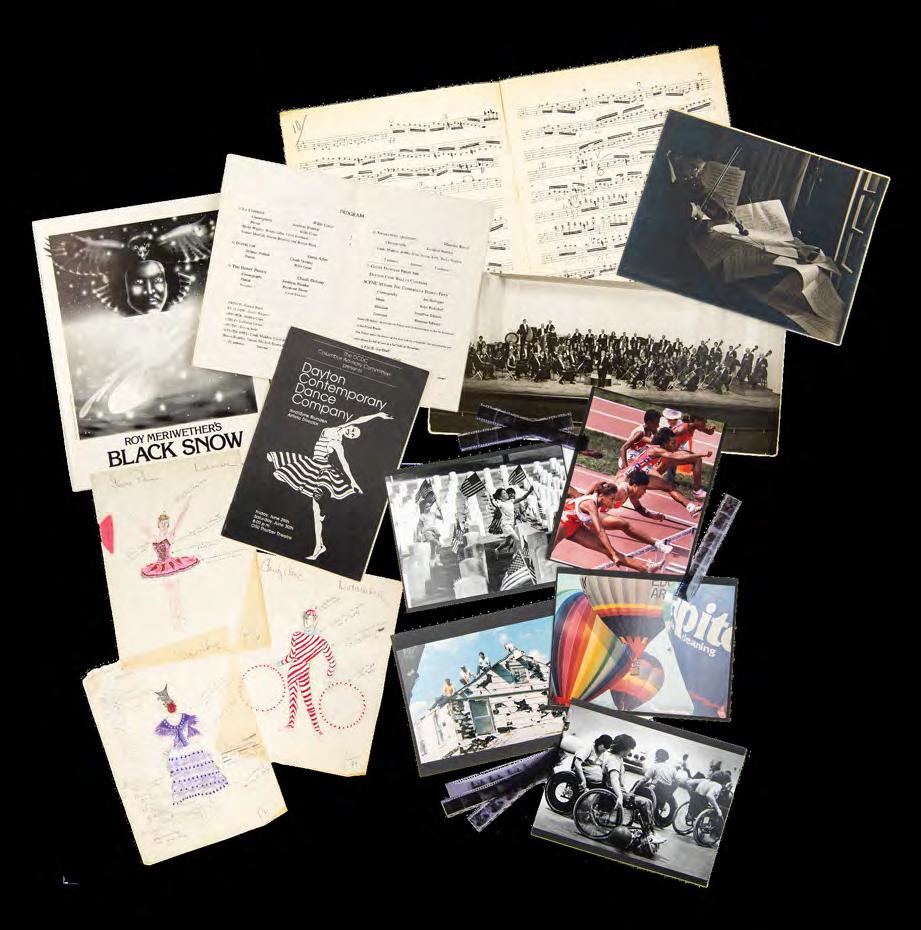
One such collection is the Dayton Ballet. Did you know that one of the first dance studios to combine modern dance and ballet was founded in Dayton? In 1927, Josephine and Hermene Schwarz established the Schwarz School of Dance, which became the Dayton Ballet.
By the 1940s, the Schwarz School opened its doors to African Americans, including Jeraldyne Blunden, who later founded the Dayton Contemporary Dance Company (DCDC) in 1968. DCDC
dance company in the nation. The DCDC collection can be found in SCA as well.
The region’s oldest and longeststanding cultural institution is the Dayton Philharmonic Orchestra, which celebrates its 90th year in 2023. In June 1933, violinist Paul Katz began the Dayton Philharmonic Orchestra. He gathered 26 professional area musicians to perform Dayton’s first symphonic concert. Katz served as the music director until 1975. The papers of Katz and the orchestra both have their home in SCA.
In terms of visual arts, a noteworthy collection is the work of award-winning photographer William Garlow. Garlow, who attended Wright State, won top awards for his work from such organizations as the National Press
Photographers, Ohio News Photographers Association, Associated Press, and Freedom Foundation. Garlow served as a photographer for the Dayton Journal Herald and Dayton Daily News beginning in 1964 and covered the news of the region for over 40 years.
These are only a few of the collections held by Wright State Special Collections and Archives documenting the visual and performing arts of the region. We welcome you to visit SCA in person or go to wright.libraryhost.com/ repositories/2/classifications/4 to view an inventory of all our arts collections. For more information on the collections in the University Libraries Special Collections and Archives, visit libraries.wright.edu/special
48 WRIGHT STATE MAGAZINE | FALL 2023
PHOTOS COURTESY OF UNIVERSITY LIBRARIES SPECIAL COLLECTIONS AND ARCHIVES
Thank You!
The WRIGHT STATE ALUMNI ASSOCIATION would like to extend a very special thank you to the following sponsors and individuals who have offered their support for this year’s event!




Breakfast Sponsor
Driving Range Sponsor







Lunch Sponsor
Hole Sponsors

Par Sponsors
Hole-in-one Sponsor

Beverage Sponsor
Player Gift Sponsor
John & Anna Monnett
Tee Sponsor




JUNE 6 2024 | BEAVERCREEK GOLF CLUB SAVE THE DATE Visit wrightstatealumni.com/golf to play or to be a sponsor.



Give back to the PACK! OCT 3 wright.edu/ wrightday2give Scan Now to Give! Wright State Alumni Association 3640 Colonel Glenn Hwy. Dayton, OH 45435-0001 NONPROFIT ORG. U.S. POSTAGE PAID BURLINGTON, VT PERMIT NO. 19






























 —CHRIS WYDMAN ’94, ’97
—CHRIS WYDMAN ’94, ’97













 BY JEN PAPADAKIS
BY JEN PAPADAKIS








 ALEXIS ARIANA ’23 (MUSICAL THEATRE) REHEARSES FOR THE ARTSGALA OPENING CEREMONY.
ALEXIS ARIANA ’23 (MUSICAL THEATRE) REHEARSES FOR THE ARTSGALA OPENING CEREMONY.
















 BY SARAH CAVENDER ’20
BY SARAH CAVENDER ’20








 Caribbean & Panama Canal February 26–March 7, 2024
Marvelous Mediterranean May 15–25, 2024
Caribbean & Panama Canal February 26–March 7, 2024
Marvelous Mediterranean May 15–25, 2024





 BY KIM PATTON
BY KIM PATTON












































